Engineering Summer Experience
University of Idaho College of Engineering students spend their summers in paid, hands-on mentorship, internship and employment positions. Many accept positions with leading industry partners or in our nationally recognized, on-campus research centers.
Read more about what our students are doing to fund their college education while gaining hands-on experience directly related to their areas of study.
Yangden Lama
Civil Engineering

Vandal engineers impact safe and smart transit at the national level!
Civil engineering junior Yangden Lama recently presented at the National Travel Monitoring Exposition and Conference. Her conference attendance is part of her internship with the National Institute for Advanced Transportation Technology (NIATT).
Located on the Moscow campus, NIATT is part of a six-member multi-institutional consortium that conducts research funded by the U.S. Department of Transportation to address transportation and mobility needs in the Pacific Northwest, using technological advances to develop data-driven, sustainable solutions for our diverse transportation needs.
Yangden said the internship has expanded her understanding of civil engineering.
“When I first started taking classes, I thought civil engineering was structures – bridges and buildings,” she said. “But the roads and highways in and around those structures, those pose an entirely different set of challenges in need of solutions.”
Shariar Talukder, Md. Abir Islam Mishad
Mechanical Engineering, Computer Engineering

Vandal engineers earn top placement in ag robotics competitions at the national level!
Engineering students Shariar Talukder and Md. Abir Islam Mishad took second place in the American Society of Agricultural and Biological Engineers 2024 Agriculture Robotics Student Competition!
Led by College of Agricultural and Life Sciences Assistant Professor and club faculty advisor Johnny Li, the team competed nationally against 21 universities to develop a fully autonomous robot able to perform a simulated agricultural operation.
This year, teams built autonomous robots to tend to strawberry plants. Teams score points by producing a robot that can navigate the field, distinguish between healthy and unhealthy leaf clusters, and trim unhealthy clusters and undesired flowers.
Robots must be capable of completing tasks without human intervention, and scoring is based on the speed and accuracy of the robots’ performance.
Thank you to our competition supporters, the NASA Idaho Space Grant Consortium, U of I Department of Soil and Water Systems, the CALS Dean’s Award, and to Pape Machinery’s Jeff Solbrack, precision agriculture specialist and general manager in the Walla Walla region.
The Vandal Robotics Club is open to all U of I students. Project teams participate in our college’s nationally recognized Interdisciplinary Capstone Design Program. The club also tours local industries and educational campuses to learn about robotic applications and research in the region and conducts K-12 outreach. To join, email engr-clubs@uidaho.edu.
Samuel Mbah
Mechanical Engineering

Vandal engineers gain insight into complex industrial systems through paid internships with industry leaders!
Mechanical engineering senior Samuel Mbah spent his summer at Schweitzer Engineering Laboratories’ new Printed Circuit Board Factory in Moscow.
The 162,000-square-foot facility is one of the only printed circuit board manufacturing facilities built in the U.S. in the last decade. SEL is a global leader in products and solutions that protect and control electric power systems, and printed circuit boards are a critical component of the devices it manufactures. The factory uses highly automated processes focused on quality, efficiency and sustainability.
Samuel’s internship focused on the mechanical aspects of the factory, including short-term quality improvements and long-term process revision, allowing him to apply both his theoretical knowledge and hands-on skills.
“SEL has provided me with every resource needed to tackle challenges, which has significantly enhanced my problem-solving skills,” he said. “I’m part of a team that’s only about three years old, but already embodies SEL’s core values of quality, discipline, communication and creativity. The team’s commitment to problem-solving and continuous improvement is truly inspiring, and it’s been a great learning environment for me.”
Laura Harris
Computer Engineering

For many Vandal engineers, internships lead to consecutive opportunities for hands-on experience with leading industry.
Computer engineering sophomore Laura Harris is spending her second summer with global leader in power protection and control, Schweitzer Engineering Laboratories, working as a software engineering intern in infrastructure defense.
“I get to apply the material I have been learning in my classes to real-world situations,” Laura said. “I am excited to have the opportunity to gain work experience while in college and grow my engineering knowledge and skills over the summer.”
Emile Johnson
Mechanical Engineering

Emile Johnson is spending her summer improving components of complex robotic exoskeletons to enhance therapeutic medicine!
The mechanical engineering sophomore is a Summer Undergraduate Research Fellow (SURF) in the University of Idaho Assistive Robotics Lab, co-directed by Dean and Cindy Haagenson Mechanical Engineering Endowed Professor Eric Wolbrecht and Associate Mechanical Engineering Professor Joel Perry.
The lab specializes in robotic exoskeletons that can be used by patients who have suffered a neurological disorder, like stroke, or have physical impairment that makes it difficult to perform everyday activities.
Johnson is redesigning orthotic components of the robotic exoskeleton to improve comfort, alignment, and adjustability. She is using a variety of 3D-printed materials and different types of silicones to develop a compliant mechanism.
For testing, she is developing a pressure-sensing model that will help identify areas of high pressure in the device that may lead to patient discomfort, and a mounted laser to measure misalignment that may make therapy less effective.
Advanced robotic exoskeletons, like the one Johnson is working on, assess a patient’s level of impairment and gather data to help medical professionals improve therapies and treatment, which can then be performed using the exoskeleton.
Johnson’s SURF experience is funded through the U of I Office of Undergraduate Research.
Jake Gendreau and Aiden Shepard
Computer Science

Jake Gendreau and Aiden Shepard are spending their summer making marine geology easy to understand through video game development!
The computer science students are working at the University of Idaho Polymorphic Games Studio, putting the finishing touches on an educational video game called Pakicetus Redux.
In the game, humanity has been forced to move from living on land to living underwater. As captain of the submarine Salvation, players manage resources for survival while escaping robots initially intended to clean the environment – who also see the human colony as oceanic waste.
Game development is led by Eric Mittelstaedt, associate professor in the U of I Department of Earth and Spatial Sciences, with the goal to help players learn more about marine geology through geologic events and deep-sea exploration.
“The best part about computer science in video game design is you have complete control over this world,” said Gendreau. “You have so much freedom in the code, but it’s also challenging because you have to come up with gameplay that other people will also think is fun.”
Gendreau is adjusting code to enhance level design and progression of the game. Shepard is focused on feature programming, game balance, and bug fixes.
The Polymorphic Games Studio specializes in evolutionary video games with populations of creatures that evolve specifically to beat a player’s strategy.
The interdisciplinary studio welcomes programmers, artists, writers, musicians, marketers, and biologists to create educational video games that feature STEM concepts for enthusiasts, educators and researchers.
Will Schaal
Chemical Engineering

Vandal engineers are improving materials used in medicine!
Chemical engineering senior Will Schaal is studying the interaction between proteins and material interfaces in Chemical Engineering Associate Professor Matt Bernards’ lab. Schaal’s research focuses on building crosslinkers and using them to form polymers. He is measuring the effects the crosslinkers have on the degradation behavior and mechanical strength of a specific material known for its nonfouling properties.
This nonfouling polymer is important because it resists protein adsorption and bacteria adhesion and has major application in coatings for biomedical devices, including sensors, joint replacements and more. Nonfouling properties keep implanted devices in the body from being identified as foreign and rejected.
Julia Palmer
Biological Engineering

Vandal engineers are improving engineered tissues for tendon injury and replacement.
Biological engineering student Julia Palmer is spending her summer in Nathan Schiele’s Tendon Tissue Engineering Lab, studying the role of a specific cell signaling pathway in regulating the production of lysyl oxidase (LOX). LOX is an enzyme that is produced by cells and is responsible for crosslinking collagen, a main structural component of tendon. This is needed for strong tendons to withstand various movements such as walking or running.
This is Palmer’s second summer working in the lab. Her research is funded collaboratively by Idaho IDeA Network of Biomedical Research Excellence (INBRE) and the Office of Undergraduate Research Summer Undergraduate Research Fellowship (SURF) programs. She was previously an Idaho INBRE Fellow. Palmer is looking forward to continuing to develop her lab techniques and writing skills while growing her professional skills.
“The INBRE program has been such an incredible experience for my engineering educational development. The exposure to research in an academic setting with the guidance and support from caring staff and faculty has been an experience that has come to shape my future desires for my career,” she said.
Palmer is funded through Idaho INBRE award number P20GM103408.
Martin Tshite
Electrical Engineering

Martin Tshite is spending his summer with global power leader Schweitzer Engineering Laboratories (SEL), working with internal and external customers to understand and provide tailored solutions.
As an SEL product compliance engineer, the electrical engineering junior is part of four ongoing safety projects, including working with a team to design a feature to verify the functionality and safety of various company devices. He is also conducting tests to ensure specific devices meet international standards and regulations.
“The work at SEL is constantly evolving with new technologies and electrical engineering related standards that I keep on learning,” he said. “The SEL team of dedicated professionals genuinely cares about their projects and the industry as a whole.”
Sean Elliot
Civil Engineering

Sean Elliott is spending his summer with HMH Engineering, improving municipal water and sewer services in St. Maries, Idaho.
HMH Engineering is a locally owned civil engineering firm specializing in construction engineering and inspection, civil engineering design, materials testing and surveying.
Elliott and the team are working on a project to replace aging sewer and water lines serving St. Maries, Idaho. The team also installed a new access hole, a couple catch basins and a storm drainage line.
The civil engineering junior said the job has given him a chance to apply engineering fundamentals to solve problems and learn terminology used in the work environment.
“At the University of Idaho, I have learned that engineering is all about problem solving, and figuring out how you are going to attack a problem and go about finding the best solution,” Elliott said. “My internship is a prime example of this. Our team is responsible for planning and designing this project. The plans aren't always 100% accurate, and you are going to come across different issues that you find underground that were not accounted for. Having this supportive and helpful team that HMH Engineering has made the process easier and attainable when finding the right solution."
Past Summer Experiences
From House to 3D-Printed Home
View ProfileMckenzie Reid, William Thielman, William Huntsman, and Joseph Cicanese
Mechanical Engineering
View ProfileNASA Nationwide Eclipse Ballooning Program
View ProfileWil Jansen Van Beek
Mechanical Engineering
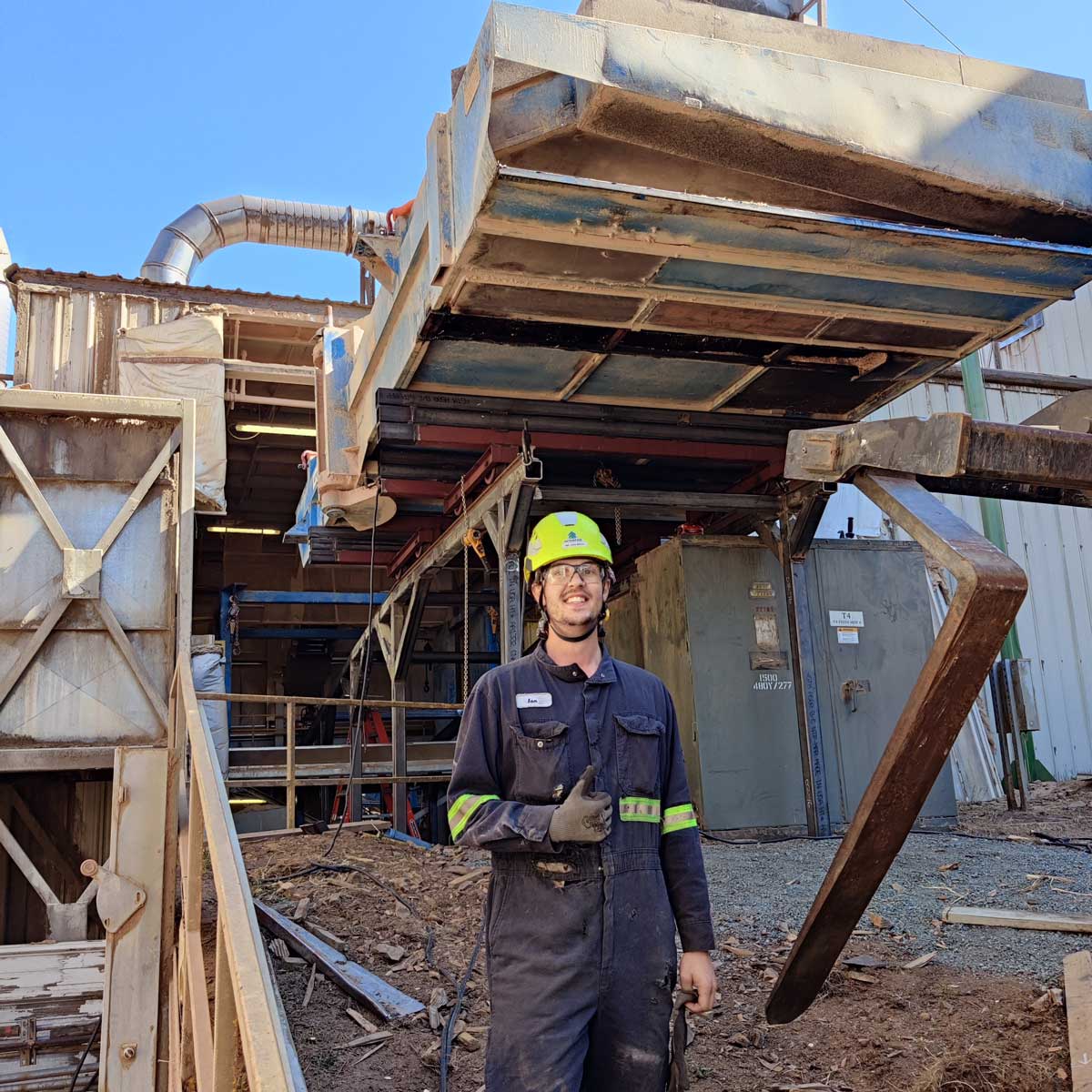
How do you move 7-and-a-half tons of machinery? Get a Vandal engineer to do it.
Wil Jansen Van Beek is spending his summer at worldwide lumber producer Interfor. He designed a low-cost temporary structure to move a critical machine at the company's Port Angeles, Washington, sawmill that was nearing the end of its useful life.
Jansen Van Beek is a University of Idaho Cooperative Education (Co-op) student, earning up to $20,000 alternating classroom study with hands-on employment experience.
“To me, engineering is solving a unique problem in a methodical and safe manner. I used all the tools and best practices available to me to make this a successful project," the mechanical engineering senior said. "Because of the skills I learned from U of I, my project was completed a day and a half ahead of schedule, and my team was able to enjoy more of the holiday weekend.”
The sawmill is powered by the waste products it generates, and this machine sorts wood waste into chips for sale or sawdust that can be used as a renewable heat source for drying lumber in kilns or powering boilers on site.
The machine was one of the original pieces of equipment on the second floor of the mill and could no longer be picked up by a crane from where it was installed. Jansen Van Beek said measurements and modeling had to be precise to minimize shutdown time at the high-production facility
“I used basic physics skills to do an analysis of the load on the structure,” he said. “I used my SolidWorks skills to create a model and the best practices taught to me by my mechanical engineering professors to create professional and efficient computer-aided design documents. I even used equations my upper-level classes to make safety decisions about bolt patterns and welds.”
Koffi Anderson Koffi
Computer Science
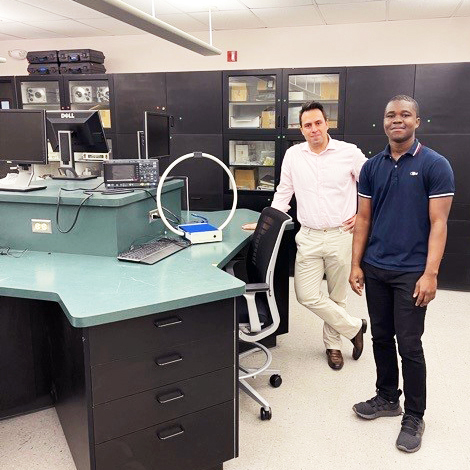
For Koffi Anderson Koffi, the key to combatting cyber-attack is a deeper understanding of changes in temperature, electrical, and electromagnetic signals in devices under attack.
Working at our Idaho Falls campus under computer science Assistant Professor Constantinos Kolias, Anderson Koffi is analyzing physical characteristics like these, using machine learning, to develop cybersecurity tools with widespread application in both the public and private sectors.
Learn more about our tech-based cybersecurity undergraduate and graduate programs and 15 dedicated faculty at the link in bio!
“Cybersecurity is a broad topic. Everyone can find a subset in what they’re interested in," he said. "It’s everything from creating secure software, developing firewalls, and other security tools to ensure the confidentiality, integrity, and availability of computer systems. There are multiple paths to choose from.”
Inside every computing device there’s a central processing unit, or CPU, an electronic device that can generate heat and electromagnetic waves.
“Understanding a base model of the functionality of a device allows us to describe that device when it’s not under a state of attack,” the first-year graduate student said. “If we know the characteristics of a device working properly under normal conditions, we can easily identify any divergence from that.”
Anderson Koffi said old solutions like antivirus don’t protect against all types of cyber attack. With some ransomware attacks and USB attacks that don’t require internet access, he said the need for a more unified solution is clear.
“Some devices have different architectures, and different companies create different devices,” he said. “This research will offer a unified way to find solutions that work across all devices.”
Lily Mason
Computer Science
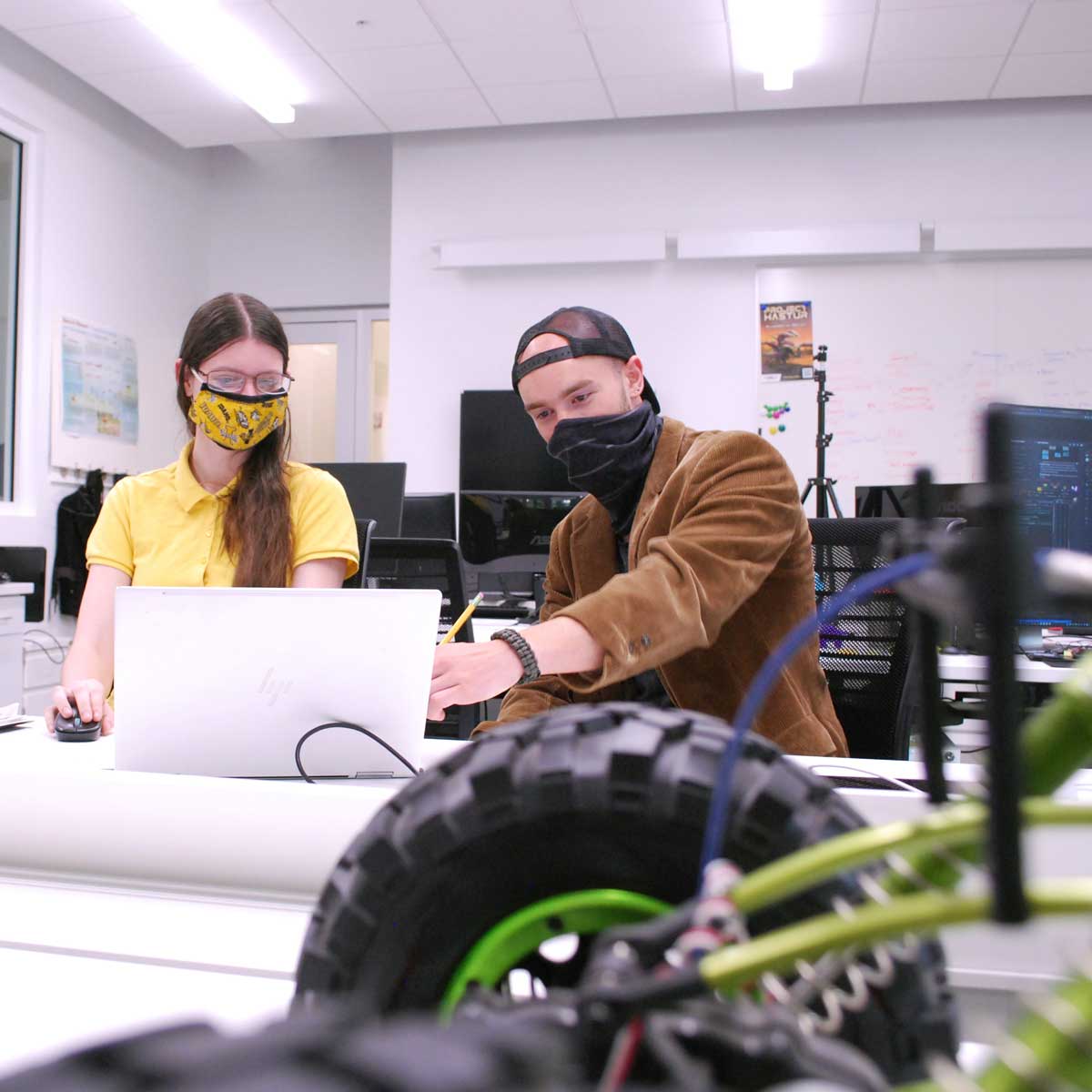
Lily Mason knows not everyone thinks like a computer.
In tic-tac-toe for example, a computer doesn’t understand the meaning of a winning three in a row, but it can learn the steps needed to get to that solution.
Mason thinks in the same way. A computer science junior and programmer at her core, she is working in our on-campus Polymorphic Game Studio, developing the user interface for a field station simulator to immerse K-12 students in a multi-player environment where they can learn more about tick-borne diseases in the U.S.
“It’s important not to overload the user with information, to provide an interface that’s correct to the game but doesn’t just make the computer programmer happy,” she said. “It has to be easy to use.”
Mason spent the summer working with fellow computer science major Ryan Wagner, graduate student Samuel Carlson and lead designer Landon Wright on the ecology-based video game.
The gameplay is connected to a nearly $6 million National Science Foundation cooperative agreement, using large and complex data sets to improve prediction and response measures for tick-borne diseases.
Shalom Masango
Junior, Mechanical Engineering
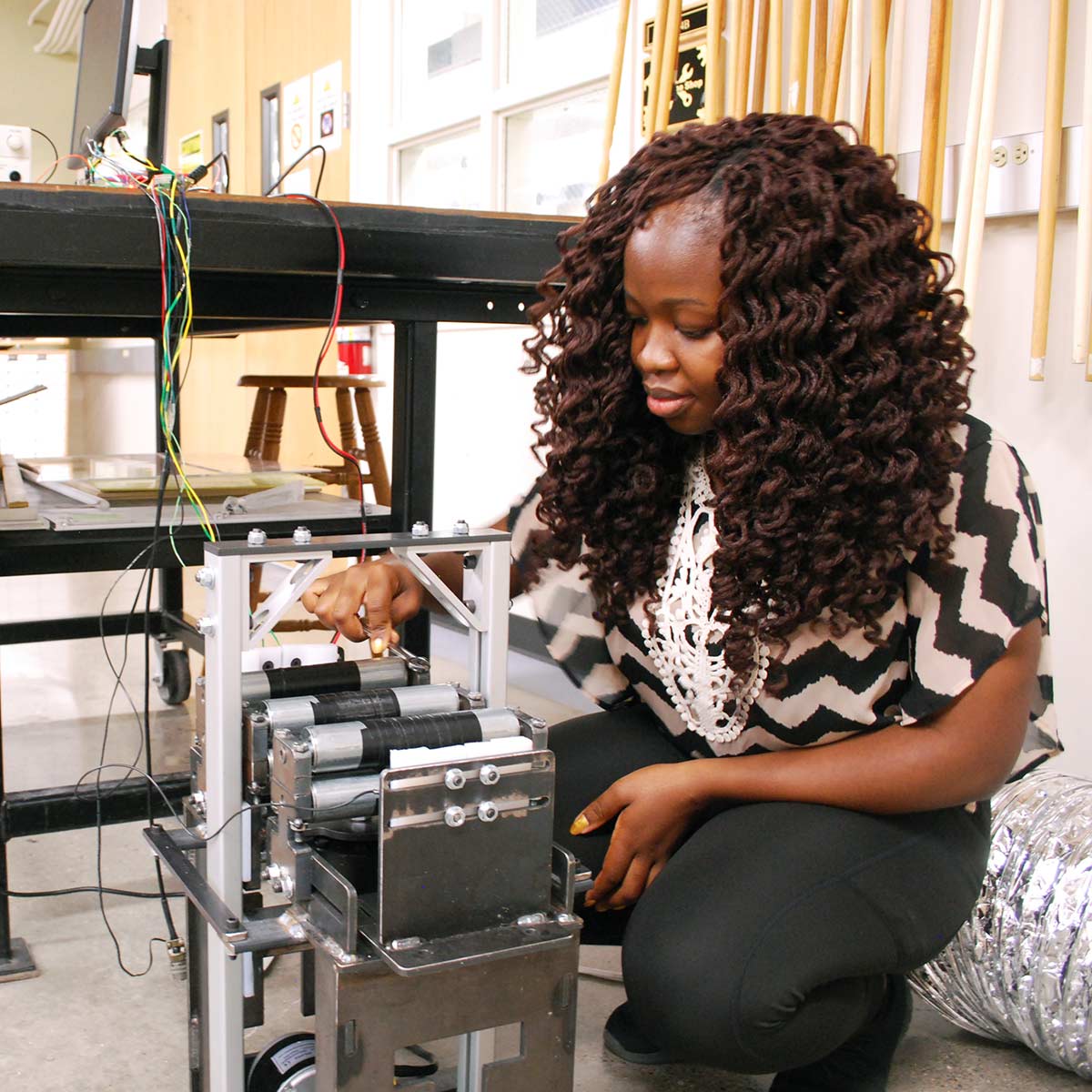
Mechanical engineering junior Shalom Masango is spending her summer keeping us connected to the power grid.
The Summer Undergraduate Research Fellowship recipient is testing the fatigue properties of a commercial aluminum used frequently by global power systems protection leader SEL Technology—Schweitzer Engineering Laboratories.
Knowing when aluminum components could fail helps design better housing to protect electronic products that are critical to large power systems.
Masango runs tests that can last anywhere from four minutes to four hours, exposing aluminum test pieces to fluctuating levels of stress.
Tests are conducted using a device custom-built by Vandal engineers in our college’s Interdisciplinary Capstone Design Program, recognized by the National Academy of Engineering as one of the top programs in the nation.
Bending metal, through vibration or direct loading, affects its durability, and it will eventually break. The device bends test pieces in quick succession, counting and recording the number of revolutions incurred before the piece fails.
Masango is using the data to, within a reasonable level of certainty, predict under what conditions a piece may fail. She said the research fulfills her interests in both mechanical engineering and computer science.
She also plans to use the experience to land a paid position with the Cooperative Education (Co-op) Program next spring. The program gives students the opportunity to alternate terms of classroom study with paid, hands-on employment experience and earn up to $20,000 per session.
Tais Mitchell
Mechanical Engineering Graduate Student
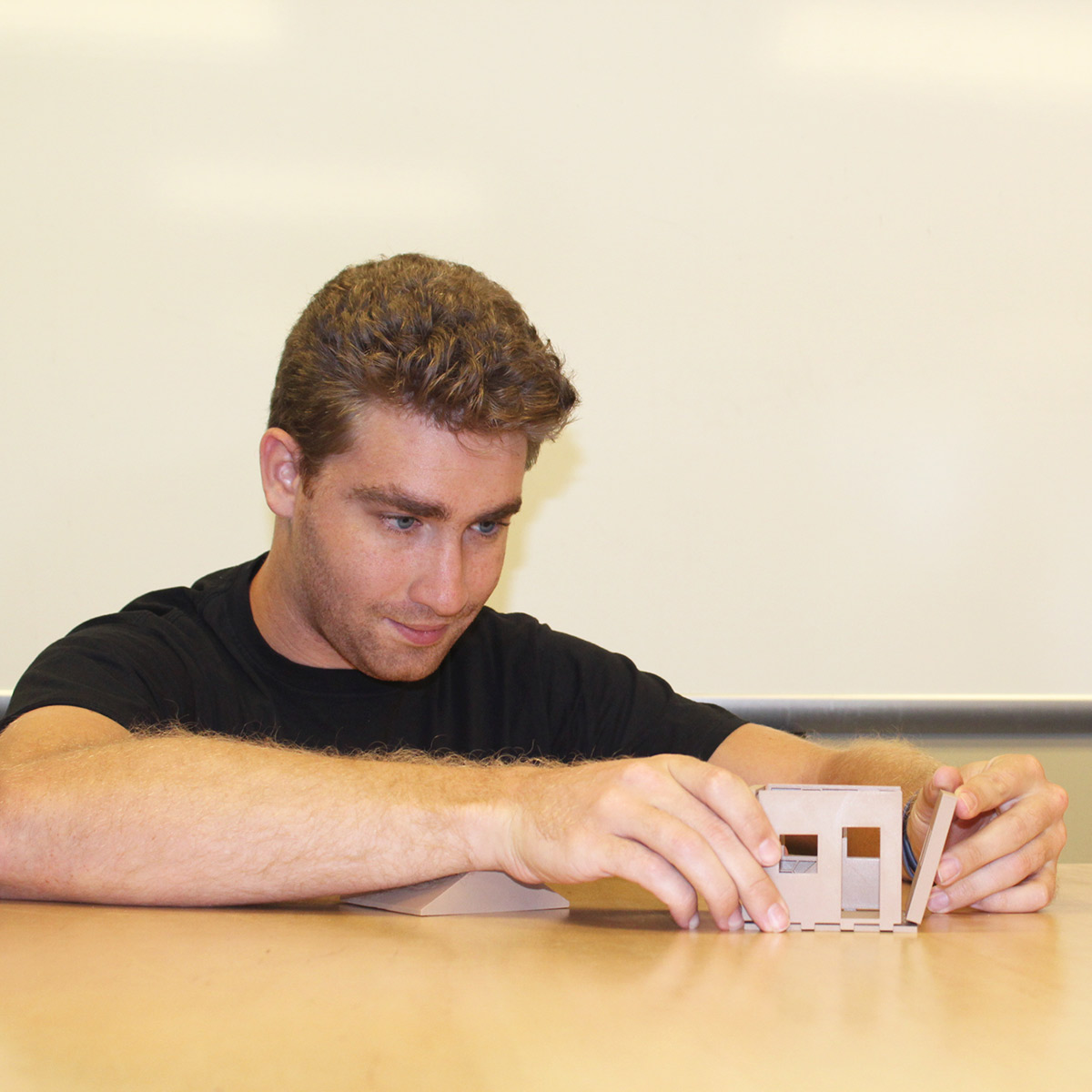
My first semester at U of I really opened up my mind to this idea of making sure we’re creating products and doing it in an environmentally conscious way. That’s the responsibility of all engineers in the 21st century.”
Mechanical engineering graduate student Tais Mitchell is improving the energy efficiency of what has the potential to be one of the most sustainable construction materials on the market.
He is part of the cross-college, interdisciplinary team working to develop a 3D-printing process for modular wall, floor and roof panels made from locally sourced Idaho wood fibers not used by the lumber market.
Working with professor Ralph Budwig and Integrated Design Lab Interim Director Damon Woods, Mitchell is looking at how heat moves through this 3D-printed material comprised of waste wood from mills and processing plants. He designed from scratch a thermal testing apparatus that can simulate and measure temperature differences between the inside and outside of a scaled prototype.
“In addition to making buildings more energy efficient, the process in which we accomplish that is also very important,” Mitchell said. “Since we are in the early design phase, we can explore using natural materials that further reduce the global warming potential and pollutants released into the air during manufacturing.”
Funded under a $1 million grant from the Higher Education Research Council and Idaho Global Entrepreneurial Mission, the project is expected to positively impact Idaho's fast-growing construction industry.
A 3D printing device is also being constructed by graduate students on the Moscow campus, and efforts continue to identify the best binding agents for the wood material.
Lindsey Smoot
Civil Engineering Graduate Student
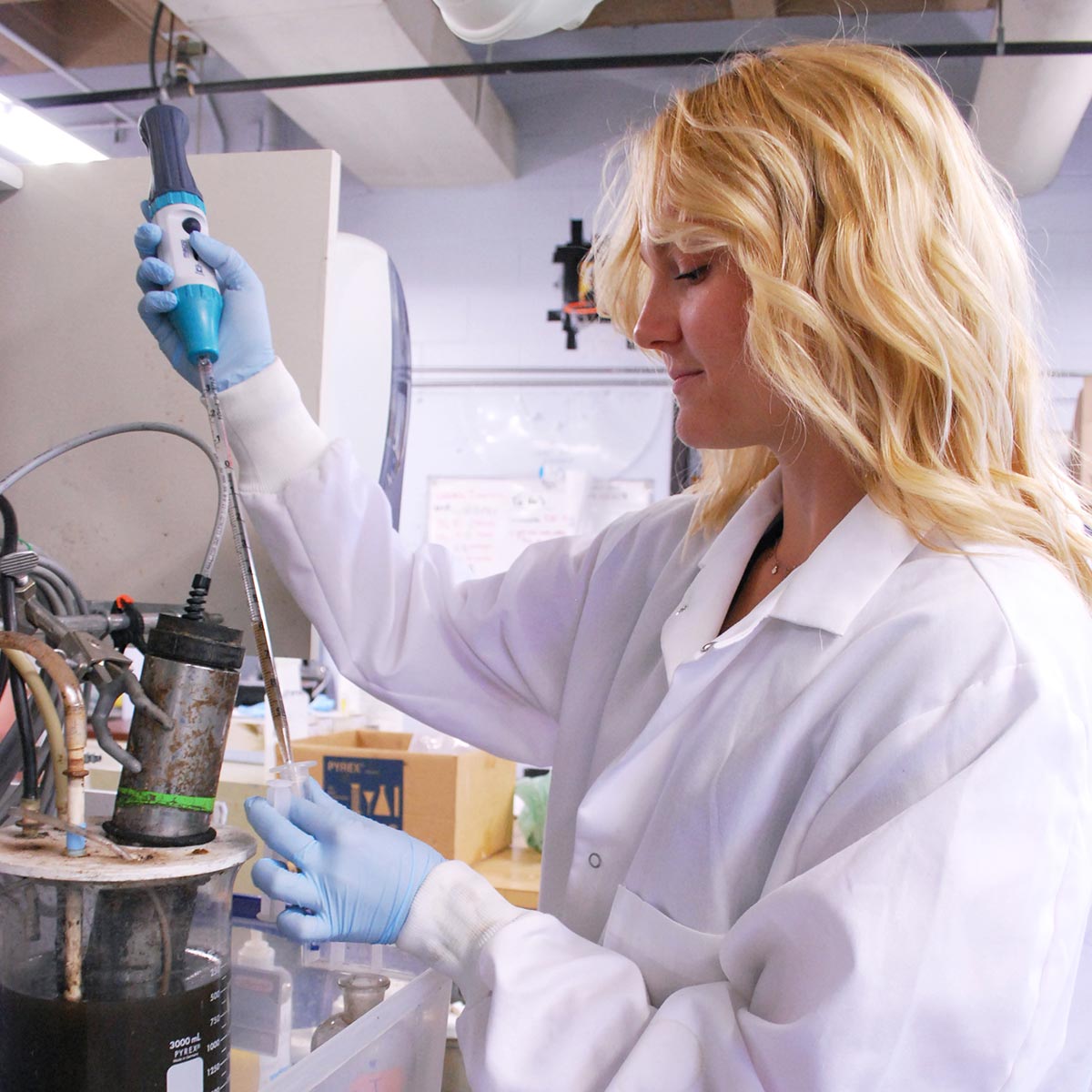
Proper wastewater treatment is essential to protecting our ecosystems and making sure we can reuse water when possible.
Civil engineering graduate student Lindsey Smoot is spending her summer improving methods that could cut wastewater treatment costs by up to 70%.
Smoot is working in Civil Engineering Professor Erik Coats Environmental Engineering Laboratory to improve biological nitrogen removal processes used in wastewater treatment.
Wastewater undergoes a two-step process called nitrification, in which high amounts of ammonia, a nitrogen compound, is converted to nitrite and nitrate.
Nitrification uses oxygen to aid the ammonia to nitrate conversion. Using bioreactors housing microorganisms in very specific environments, Smoot is looking at how a shortcut in the nitrification process could use 25% less oxygen and cut treatment cost.
Smoot started working in the lab before she finished her undergraduate degree in civil engineering in 2019.
“Water is such a resource, working in the lab has shown me how water reuse processes are going to be incredibly vital to our future.”
McKenzie Reid
Mechanical Engineering Sophomore
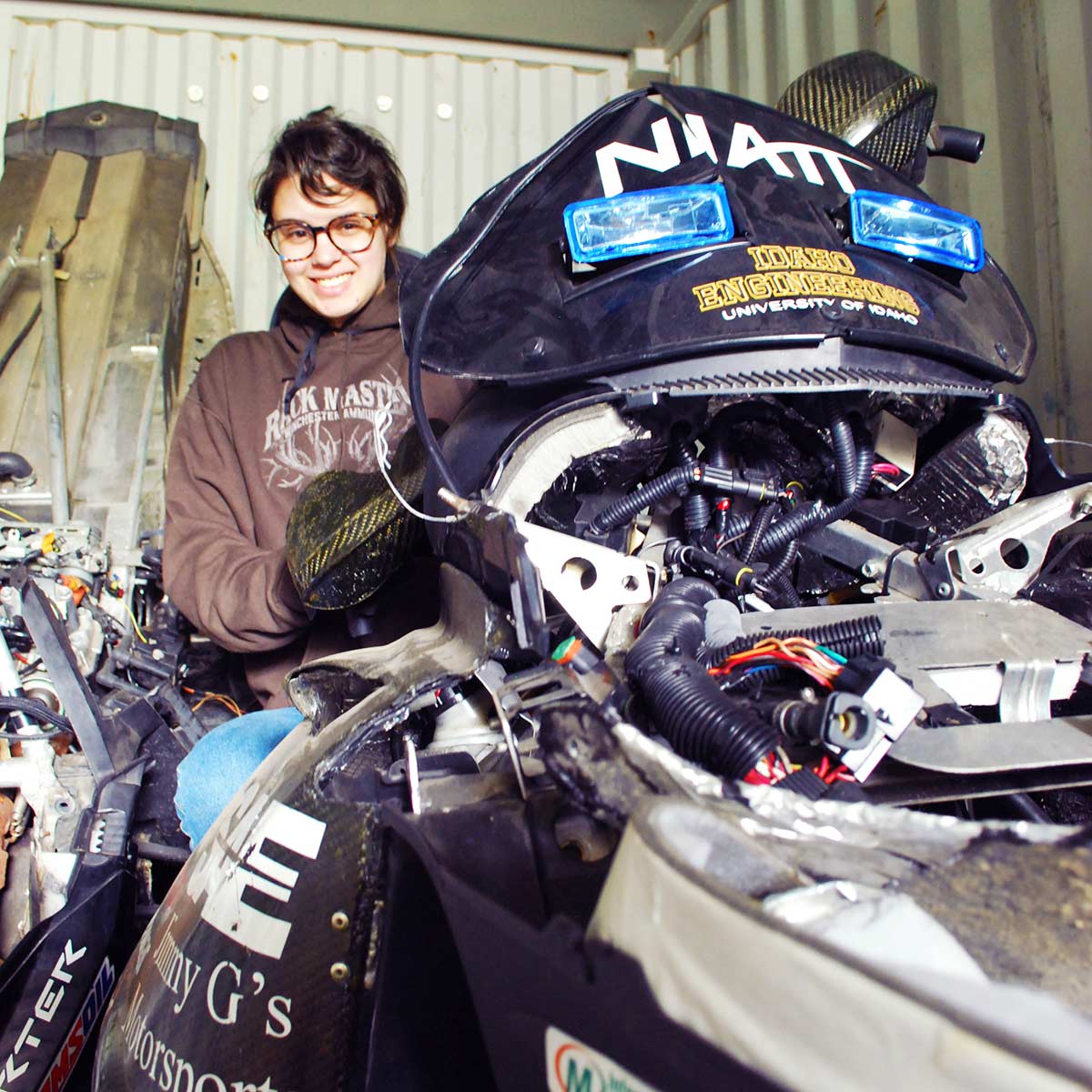
For 21 years, Vandal engineers have competed in the Society of Automotive Engineers (SAE) Clean Snowmobile Challenge. Our Clean Snowmobile Challenge (CSC) Team has collected more than 50 competition awards in that time.
Two decades of Vandal innovation has generated a lot of spare parts and retired machines!
Mechanical engineering sophomore McKenzie Reid is an intern with the National Institute for Advanced Transportation Technology (NIATT), breaking down machine equipment and sorting it into recyclable parts.
Reid said the experience has sharpened her project management skills and piqued her continued interest in how mechanical devices work.
Reid is also researching solutions this summer for the CSC team’s continuously variable transmission (CVT) test bench, designing a device to collect efficiency data on the automatic transmission system that can continuously change gear ratio.
From House to 3D-Printed Home
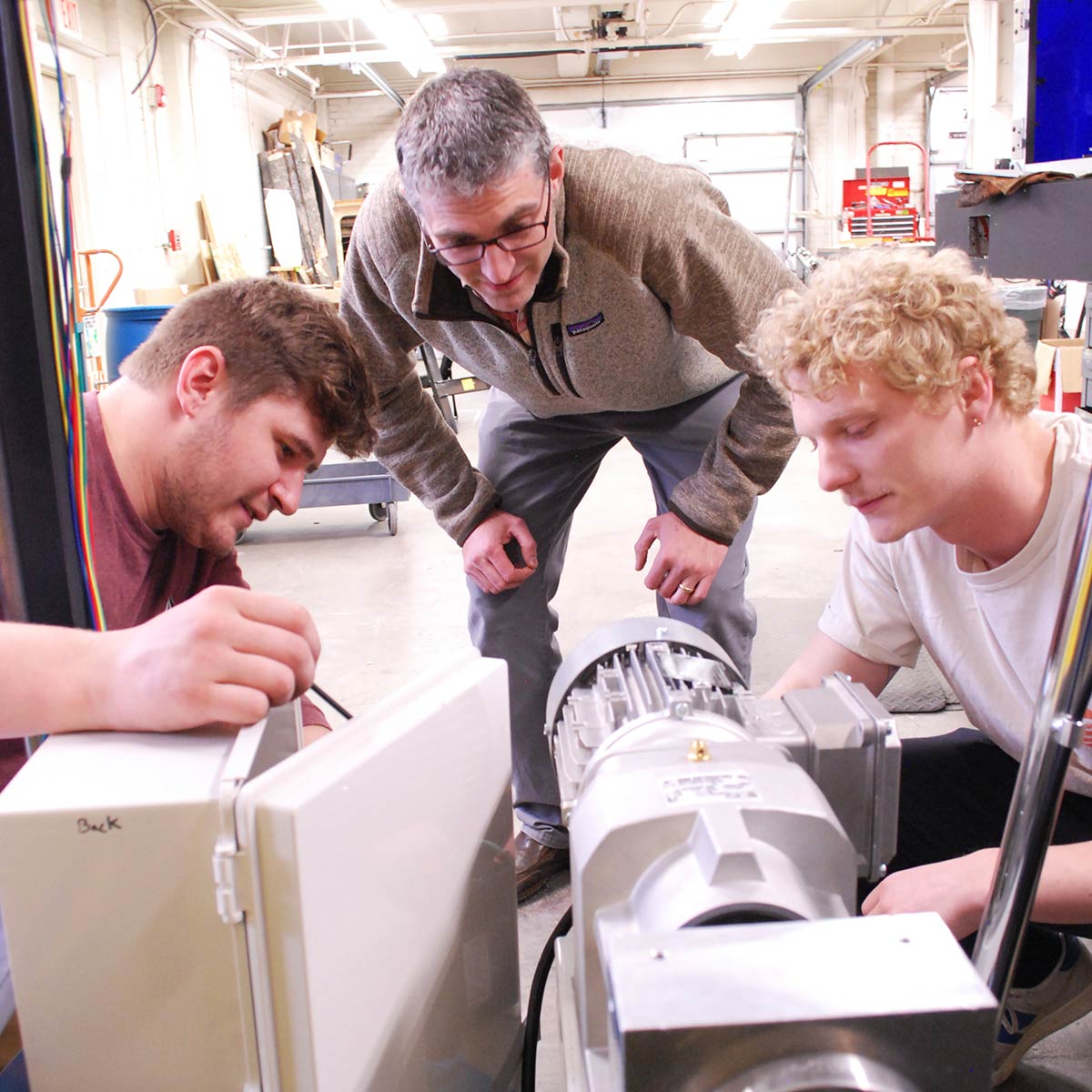
Vandal engineers are pushing the boundaries of construction and manufacturing, using one of Idaho's most natural and renewable products - wood.
Mechanical engineering graduate students Robert Carne and Conal Thie are part of a cross-college, interdisciplinary team working to develop a 3D printing process for the sustainable manufacturing of modular wall, floor and roof panels made from locally sourced wood.
Working with faculty advisor Michael Maughan, the two are continuing development and testing of a 3D printer capable creating 2-by-3-foot wood panels that can be prototyped for industrial use. The printing process uses a binding agent and wood fibers not used by the lumber market, like waste wood and sawdust from mills and wood processing plants. The team is continuing to work to refine their custom extruder design and continuous layering method.
“This could revolutionize construction,” Thie said. “If we can make houses and other structures more efficient with a lot less waste, we can also construct buildings faster, while using fewer resources and a lot less energy.”
Funded under a $1 million grant from the Higher Education Research Council and Idaho Global Entrepreneurial Mission, the project is expected to positively impact Idaho's fast-growing construction industry.
University of Idaho College of Art and Architecture’s Integrated Design Lab (IDL) research scientist Ken Baker leads the grant, and our college and the College of Natural Resources will continue to interface on the project this summer and beyond.
Under the guidance of U of I Professor of Renewable Materials Chemistry Armando McDonald, chemical engineering graduate student Berlinda Orji analyzed how different chemical compounds reacted to applied conditions to identify the best binding agents for the 3D printing material.
Focus continues to be placed not only on durability of printed materials. Our Boise team, including graduate student Tais Mitchell, professor Ralph Budwig and IDL Interim Director Damon Woods, is also continuing testing on the material’s ability to insulate and stand the test of time.
Brandon Hilliard
Mechanical Engineering Doctoral Student
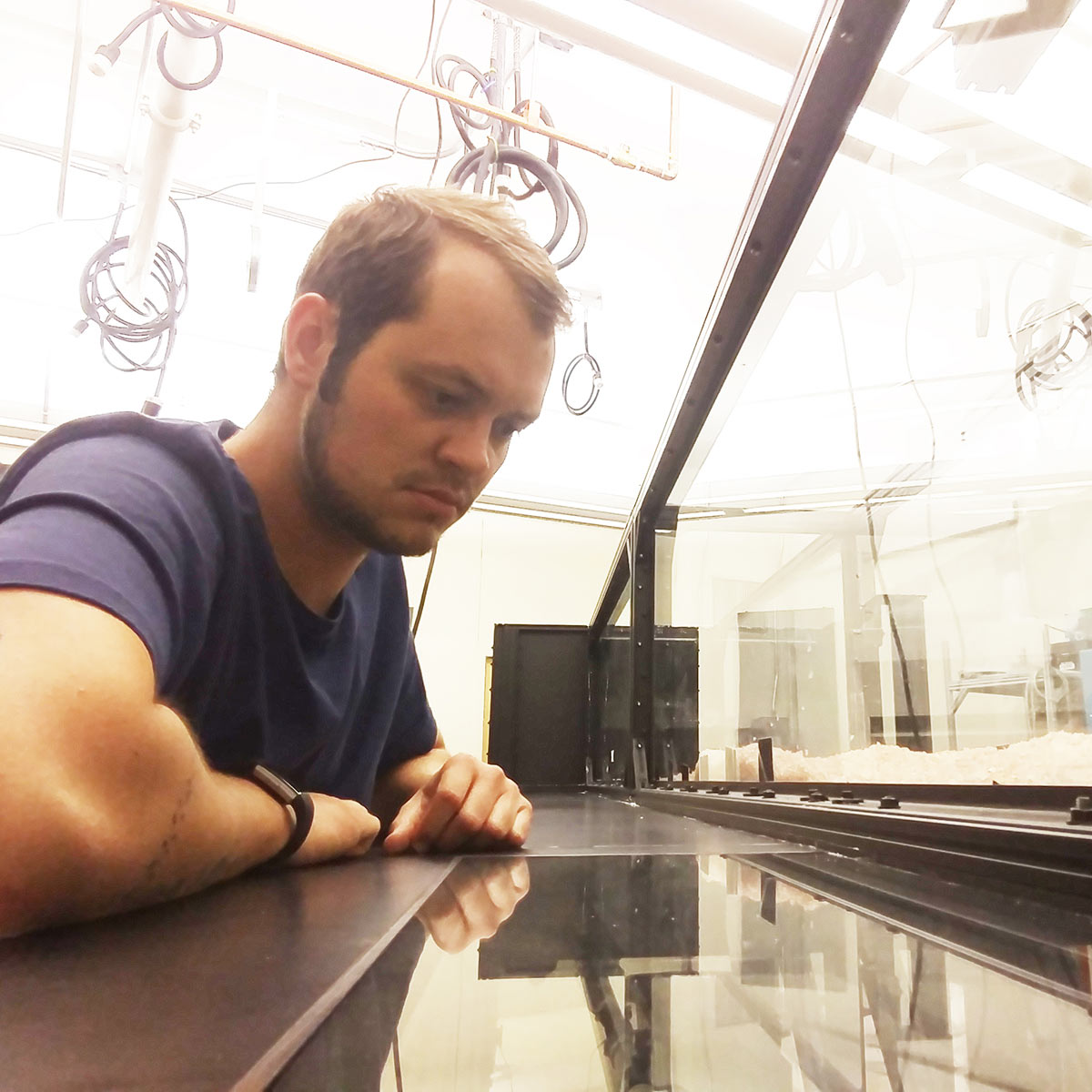
Salmon eggs rely on water flow to supply dissolved oxygen needed to grow and hatch. That flow can be disrupted in drought-prone areas, affecting fish populations.
Mechanical engineering doctoral student Brandon Hilliard is spending his summer studying the chemical and biologic processes that occur in water flow through the sediment of a simulated salmon redd, or egg nest.
Using a clear sediment simulant developed by the Boise Center for Ecohydraulics Research (CER), Hilliard is working with a team at the University of California Santa Cruz to help water management teams learn more about the water and sediment flows that salmon eggs rely on to grow properly and hatch.
Hilliard uses different methods to “see through” the clear sediment, including matching the refractive index – or how light travels through different materials – of the sediment simulant and the working fluid. He plans to also use Planar Laser-Induced Fluorescence (PLIF) to obtain flow velocities. Shining a laser through a fluorescent dye within the porous media causes the dye to emit orange light. That light is then captured using a special camera and tracked to obtain the velocities within the egg nest.
Jade Williams
Civil Engineering Class of 2021
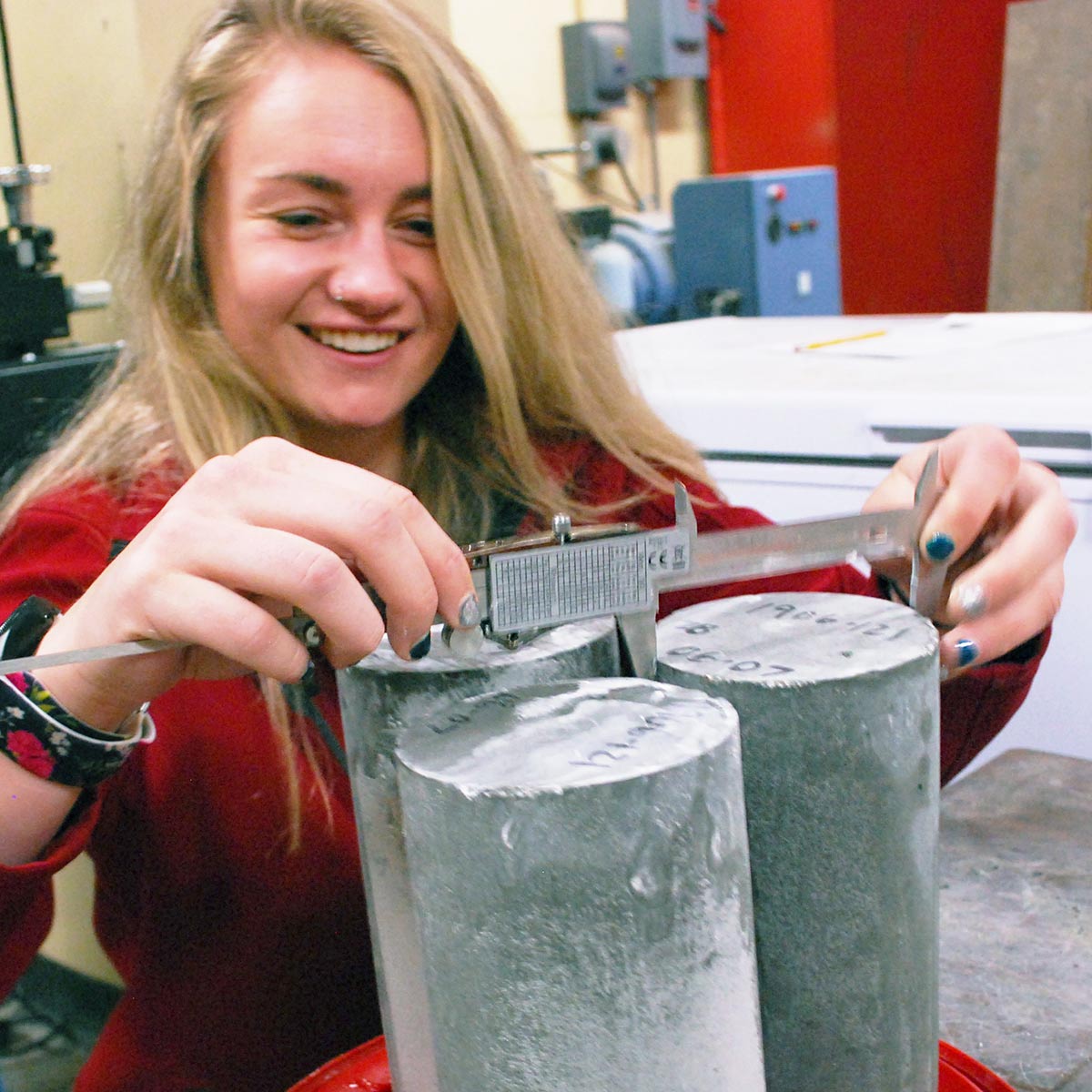
Concrete is one of the most widely used construction materials in the world, and a properly designed mixture ensures long-term strength and durability.
“As engineers, we’re always looking for ways to simplify different processes. With concrete, it’s hard to simplify, because every part of its creation is important, from the aggregates used to create it, the way it’s mixed, the way it cures, and how it’s used.”
University of Idaho civil engineering graduate Jade Williams ’21 is spending her summer working with geotechnical engineering firm Geotek, Inc., to conduct compressive strength tests on the concrete used in the construction of the Idaho Central Credit Union Arena.
So far, Williams has conducted tests on more than 500 field-cured cylinder samples taken from concrete pours around the arena. Using a compression testing machine, Williams is recording the strength of prepared samples at regular intervals throughout construction to help ensure quality and safety specifications are being met.
Williams is also interning remotely for consulting firm HMH Engineering this summer as well as conducting research for the National Institute for Advanced Transportation Technology.
Nick Buonarati
Civil Engineering Senior
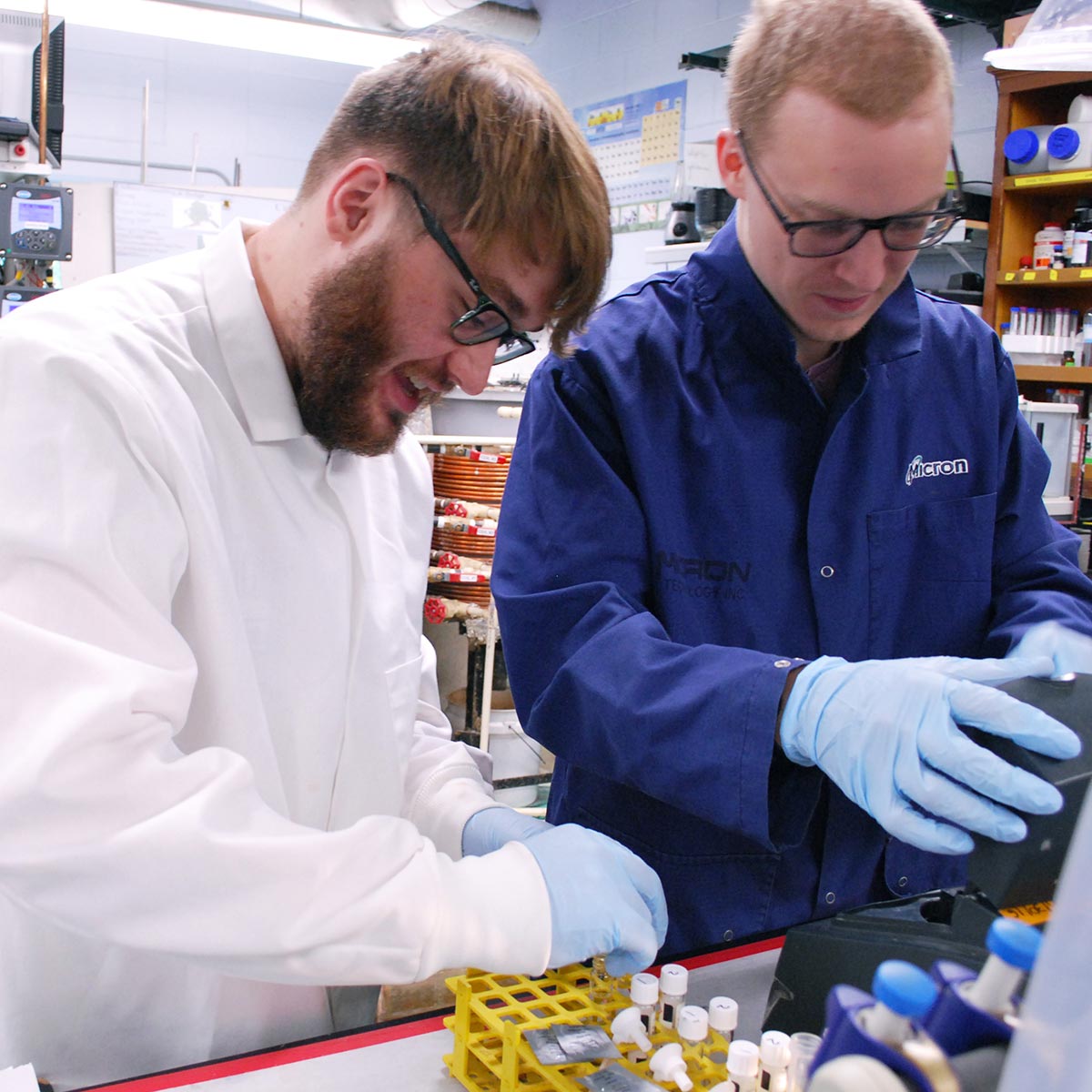
Eighty gallons of wastewater filter through the Environmental Engineering Laboratory each week.
Civil engineering senior Nick Buonarati is spending his summer making sure the innovative wastewater treatment research flowing through that water continues smoothly.
“Water is a renewable resource, but it is finite resource,” Buonarati said, “That’s why wastewater treatment is such an important process. It lets us minimize, or even negate in some instances, our impact upon the world’s water supply.”
The lab houses several bioreactors housing microorganisms in precise environments. Buonarati conducts regular tests to ensure reactor probes and calibrations are correct to make sure no research is compromised.
He also makes regular trips to Moscow’s Water Reclamation and Reuse Facility to check on other experiments going on at the scale model plant designed to mimic processes going on in the larger facility.
“Working in Dr. Coats’ Environmental Engineering Lab has been helpful in understanding how research is conducted in this field,” he said, “I am learning how treatment plants operate in class, and designing my own treatment system. I wouldn’t have the understanding that I have in this field without my lab experience.”
Adrienne Shea
Chemical Engineering
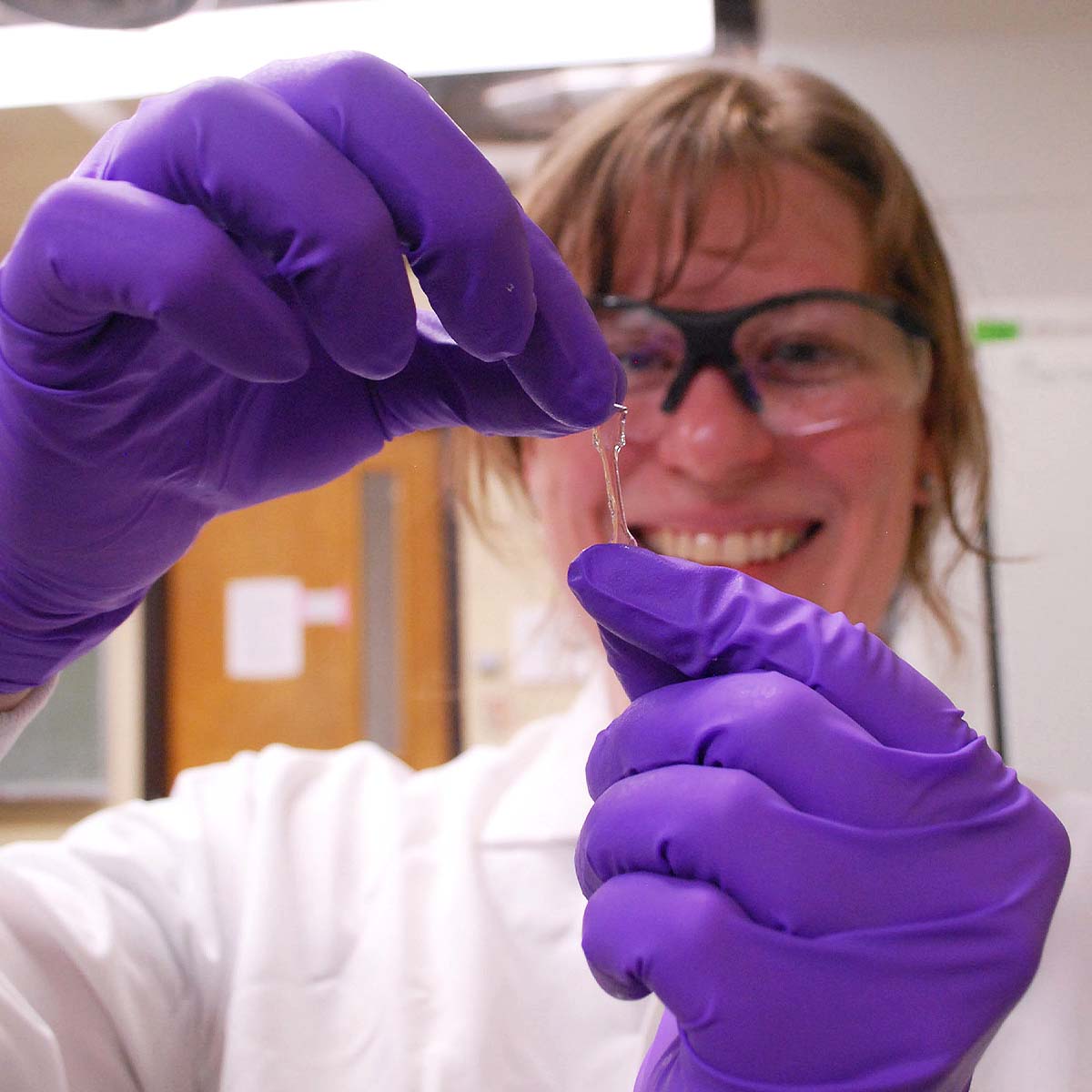
Vandal engineer Adrienne Shea is helping NASA astronauts stay healthy during space travel and expanding our understanding of the galaxy we live in.
Shea is a chemical engineering graduate fellow with the NASA Idaho Space Grant Consortium, continuing development led by Chemical Engineering Professor Matthew Bernards on a bacteria adhesion resistant coating for use in space vehicles to protect astronauts from sickness and disease.
“When astronauts are out on a mission, it’s hard to bring everyone home if someone gets an infection,” she said. “By preventing bacteria from sticking to surfaces in the first place, we can travel further while keeping everyone safe.”
Shea is developing polymers that are non-fouling and bacteria resistant, meaning they resist the collection of proteins and bacteria, allowing surfaces to stay germ-free longer and lowering the potential spread of infection.
These polymers also have major application as coatings for biomedical devices, including organ transplants, joint replacements and more. Their non-fouling properties keep devices implanted in body from being identified as foreign and rejected.
Aman Gupta
Chemical Engineering
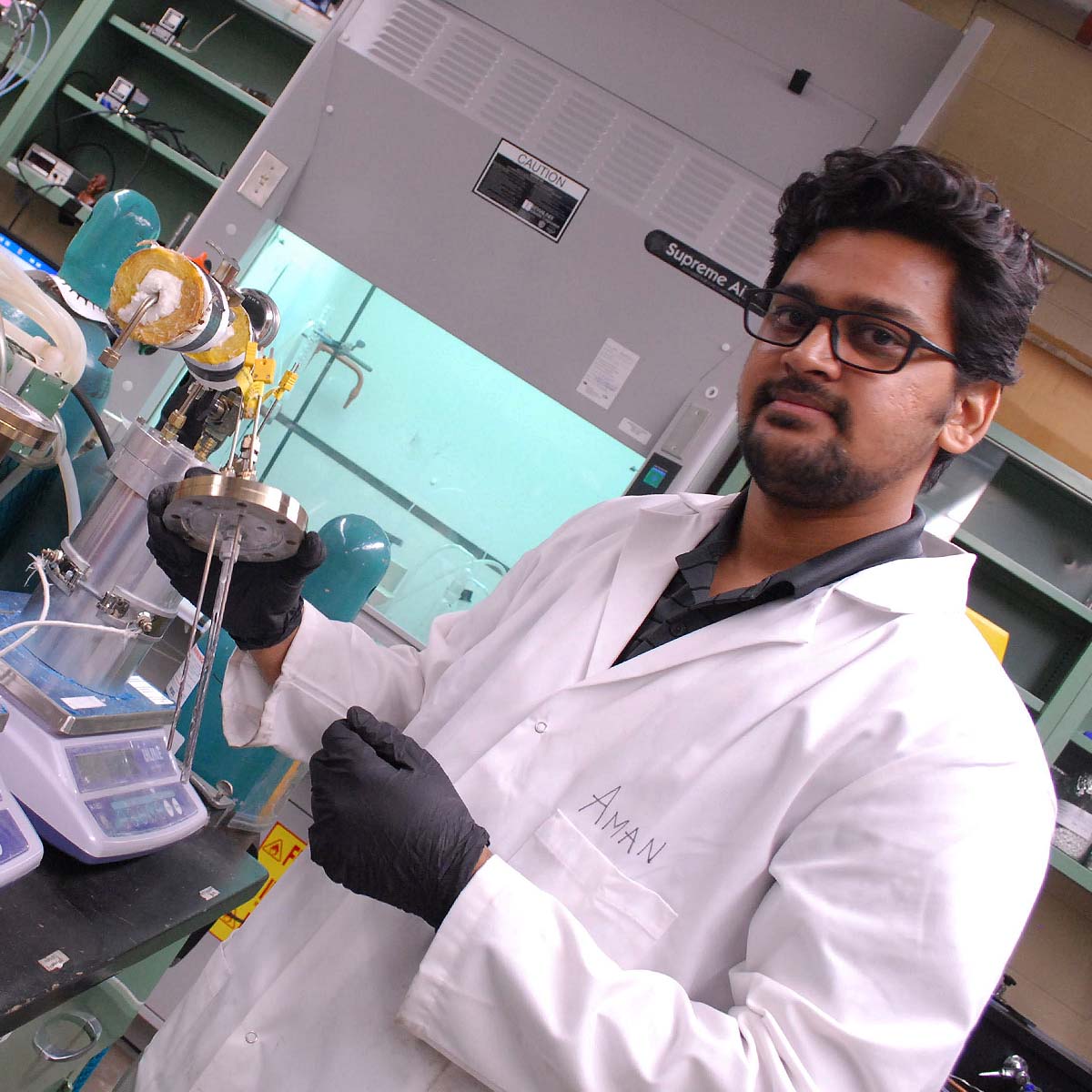
Vandal engineer Aman Gupta is spending his summer finding new ways to lower greenhouse gas emissions, producing heat and energy essential to many manufacturing processes through renewable methods.
The chemical engineering graduate student works in Chemical Engineering Professor Vivek Utgikar's lab, building a chemical heat pump and energy storage system that uses reversible chemical reaction to amplify temperature by manipulating reaction conditions to produce heat needed in many industrial manufacturing and electricity applications.
Most companies rely on fossil fuels like coal and natural gas to produce high-temperature heat needed in the production of products like petroleum and paper goods. These processes make up the largest source of greenhouse gas emissions in the U.S.
Gupta’s alternative provides a renewable heat source that can be stored at times of low electricity demand, used directly in industrial processes or reconverted into electricity at times of increased demand.
McKenzie Reid and William Thielman
Mechanical Engineering

Vandal engineers are spending quality time with Arctic Cat this summer!
Mechanical engineering juniors McKenzie Reid and William Thielman are interning at the national snowmobile and all-terrain vehicle manufacturer’s factory in Thief River Falls, Minnesota.
Reid is coding a work instruction template for the company’s manufacturing line, learning how to calibrate engines and using simulation and other manufacturing software.
Thielman is working alongside the paint engineering team to address quality control on the manufacturing line. He also helped the electrical engineering department install a functional engine and fuel test bench and is learning how to use dynamometer and calibration software with the engine calibration team.
Nicolas Burrows
Mechanical Engineering

Mechanical engineering senior Nicolas Burrows spent his summer calibrating sensors used in wind tunnel and military aircraft testing for NASA, SpaceX and Lockheed Martin.
Burrows was an intern with pressure and temperature instrumentation leader Scanivalve in Liberty Lake, Washington.
When not conducting internal volume studies of new products, component and process design improvements and designing system control panels at work, he’s pursuing his love of flying in an airplane he finished building last spring!
Rahul Bhusal
Chemical Engineering
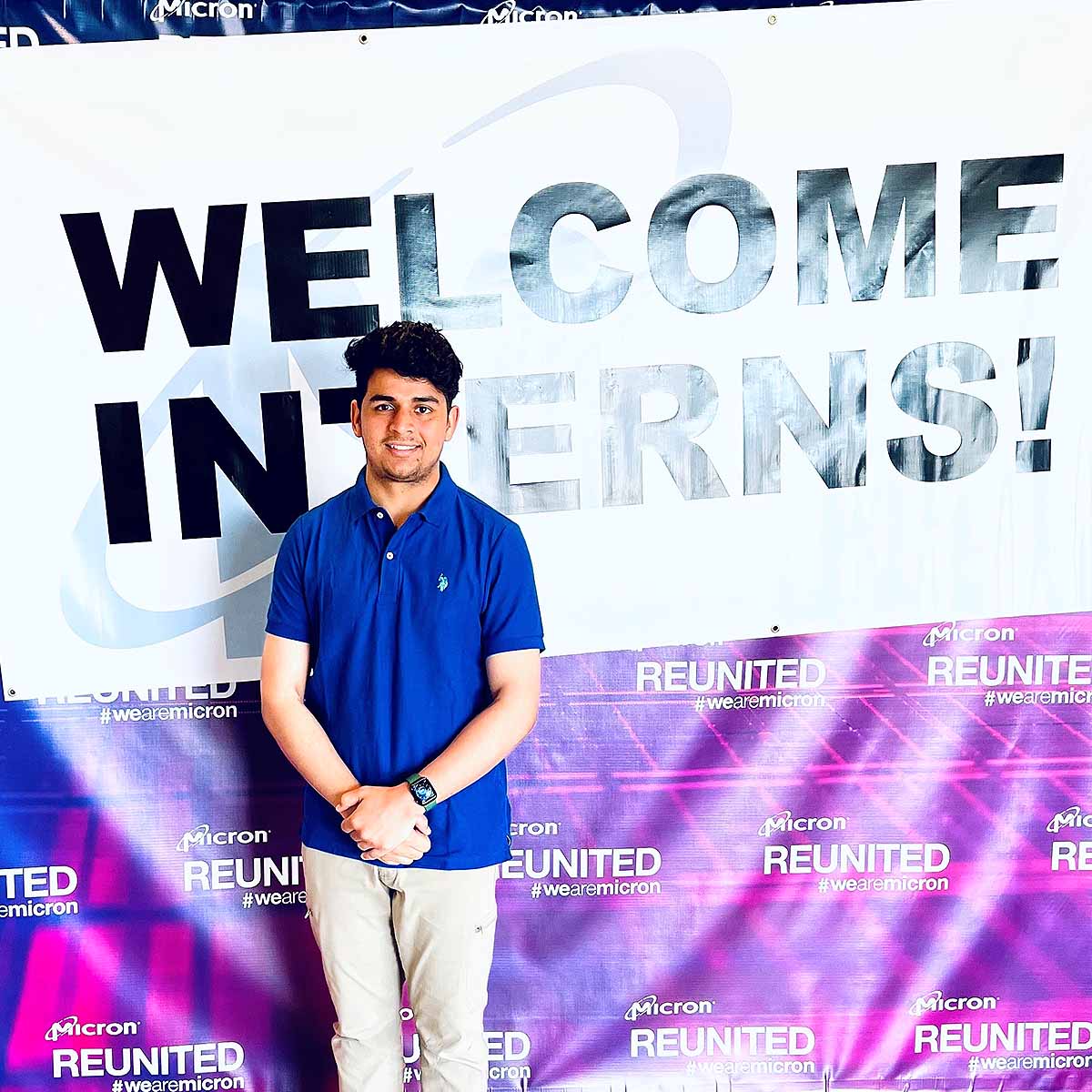
Chemical engineering senior Rahul Bhusal is spending his summer helping Micron improve processes to manufacture computer memory chips.
Bhusal works closely with a team of engineers across disciplines.
"This internship provided me with the opportunity to work in a diverse environment, which I think is one of the useful aspects of a successful career,” he said. “Working in the real world is different than university class, and Micron is helping me gain those experiences, including cooperation and how to communicate with a diverse group of professionals.”
Shalom Masango
Mechanical Engineering

Mechanical engineering senior Shalom Masango spent her summer with Applied Materials, a leader in materials engineering solutions used to produce virtually every new computer chip and advanced display in the world!
As a manufacturing engineering intern, Shalom’s role was to improve the Chemical Mechanical Planarization (CMP) process for faster build times while maintaining Applied Materials' high quality standards and commitment to a safe workplace.
CMP is a material removal step that occurs at several points in the fabrication process of the silicon wafers that make up computer chips. CMP tools ensure a wafer meets precise flatness specifications that enable further processing. This is done through a process of polishing the wafer using an abrasive polishing slurry.
In the fast-paced environment of manufacturing engineering, Shalom worked on packaging improvements to prevent shipment damage, corrective actions for parts that recently failed, mapping and streamlining the build and test of CMP products, and designing and 3D printing jigs to facilitate CMP manufacturing.
Troy Hanes
Mechanical Engineering
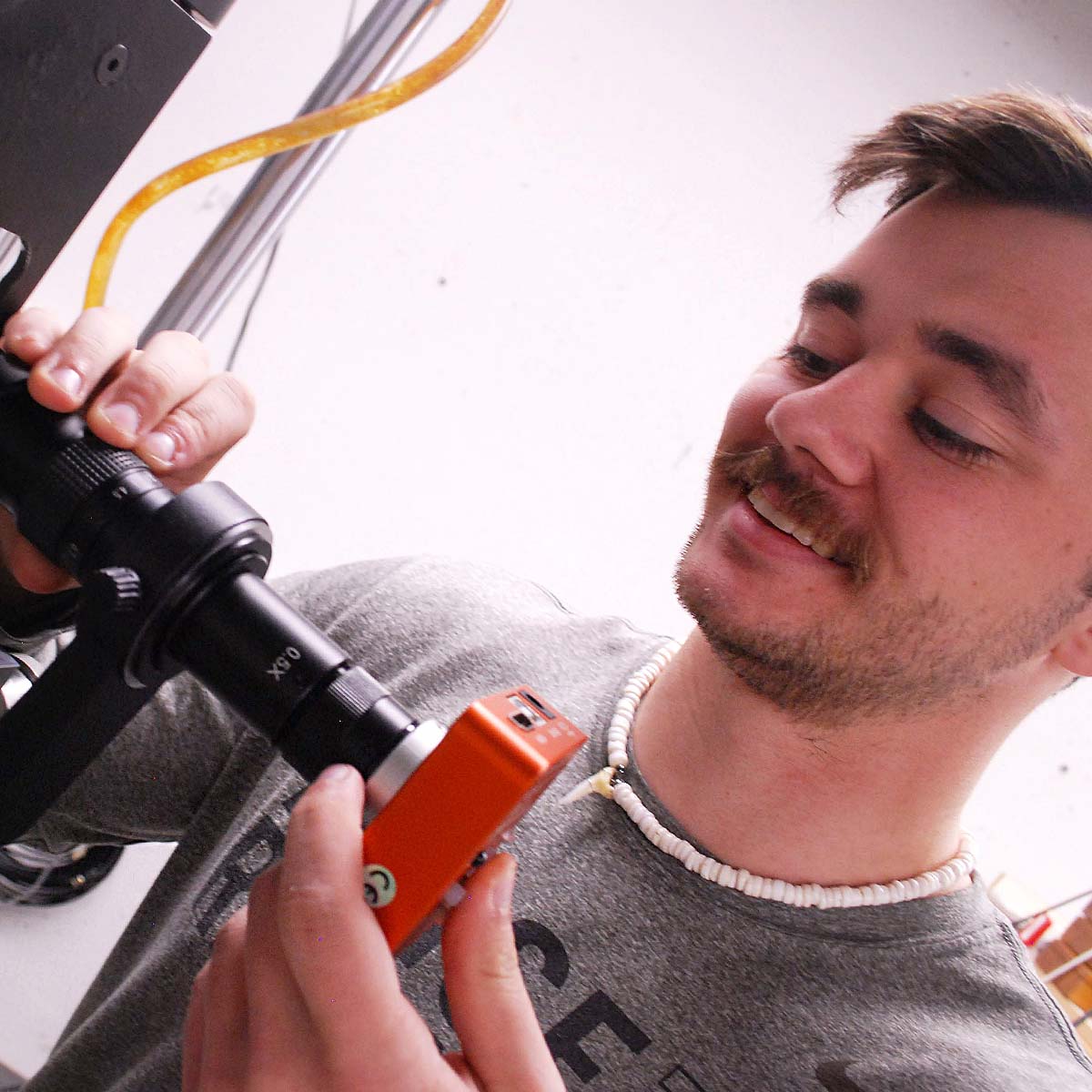
Over time, all metals will crack. For modern applications – from airplane fuselages to gas lines and protective roofs – the important question is, when?
Mechanical engineering senior Troy Hanes is spending his summer testing high-heat superalloys using specialized devices, some constructed by students within the lab, to research creep fatigue, or the deformation or cracking of material placed under mechanical loads – physical stress or force – and high heat..
“For parts that are designed to be replaced, like parts in a car, cracks are to be expected,” Hanes said. “But for parts you can’t replace, like a turbine or a reactor, we need to be able to anticipate when that machinery might fail for proper maintenance and safety.”
Test pieces of nickel-based and stainless-steel alloys are placed under intense heat and physical stress,, and cracks within the metal are assessed as they develop. While some metals fail early, Hanes said one of the tests in the lab has been ongoing for more than 80 days.
Alex Sorensen
Chemical Engineering
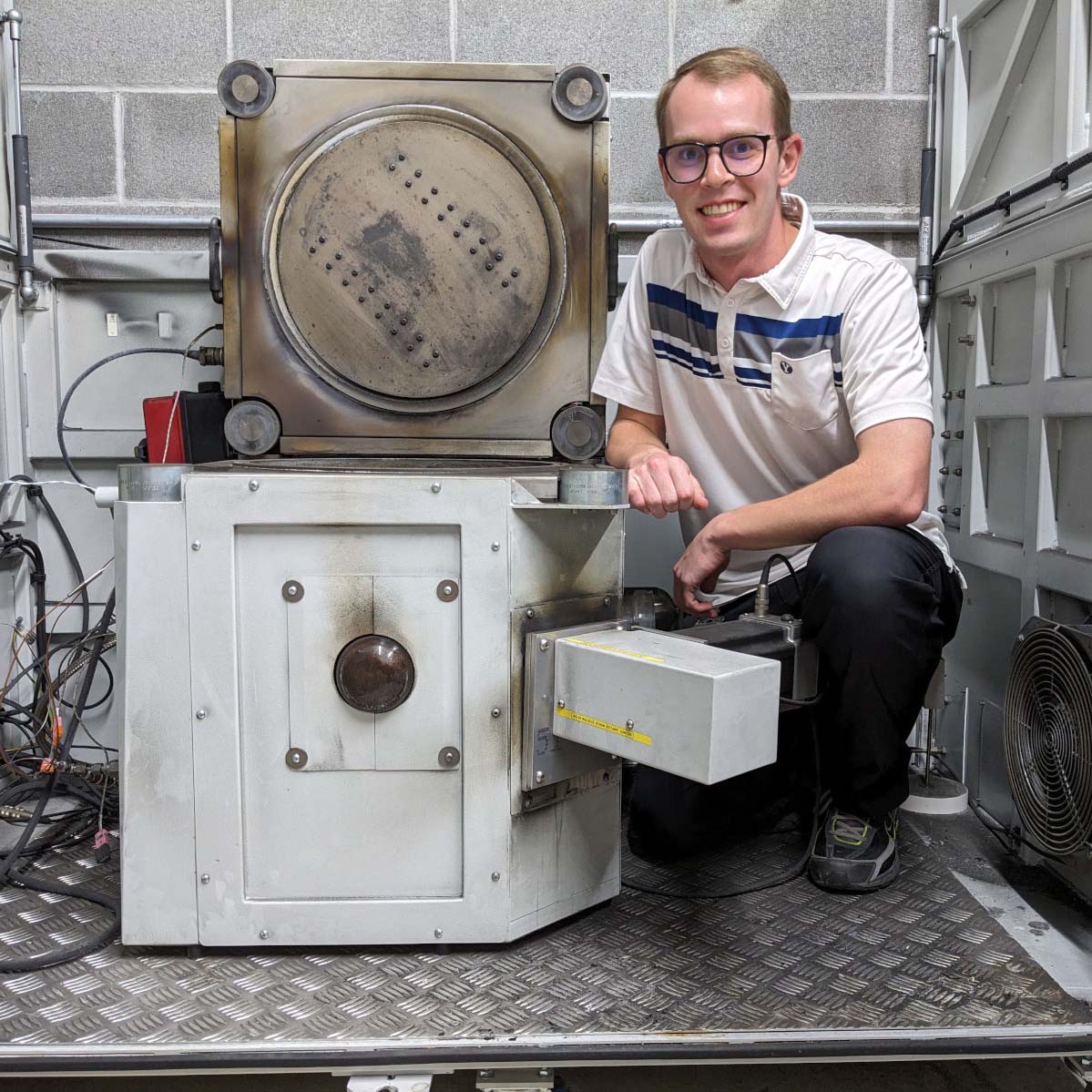
Vandal engineers are developing large format lithium-ion batteries for aircraft propulsion!
Chemical Engineering graduate student Alex Sorensen works for Electric Power Systems in Logan, Utah, as a chemical engineer.
Sorensen’s research focuses specifically on lithium-ion battery safety, developing a numerical prediction model to identify critical maximum temperatures and energy release during battery failure.
Aneesha Shrestha
Computer Science
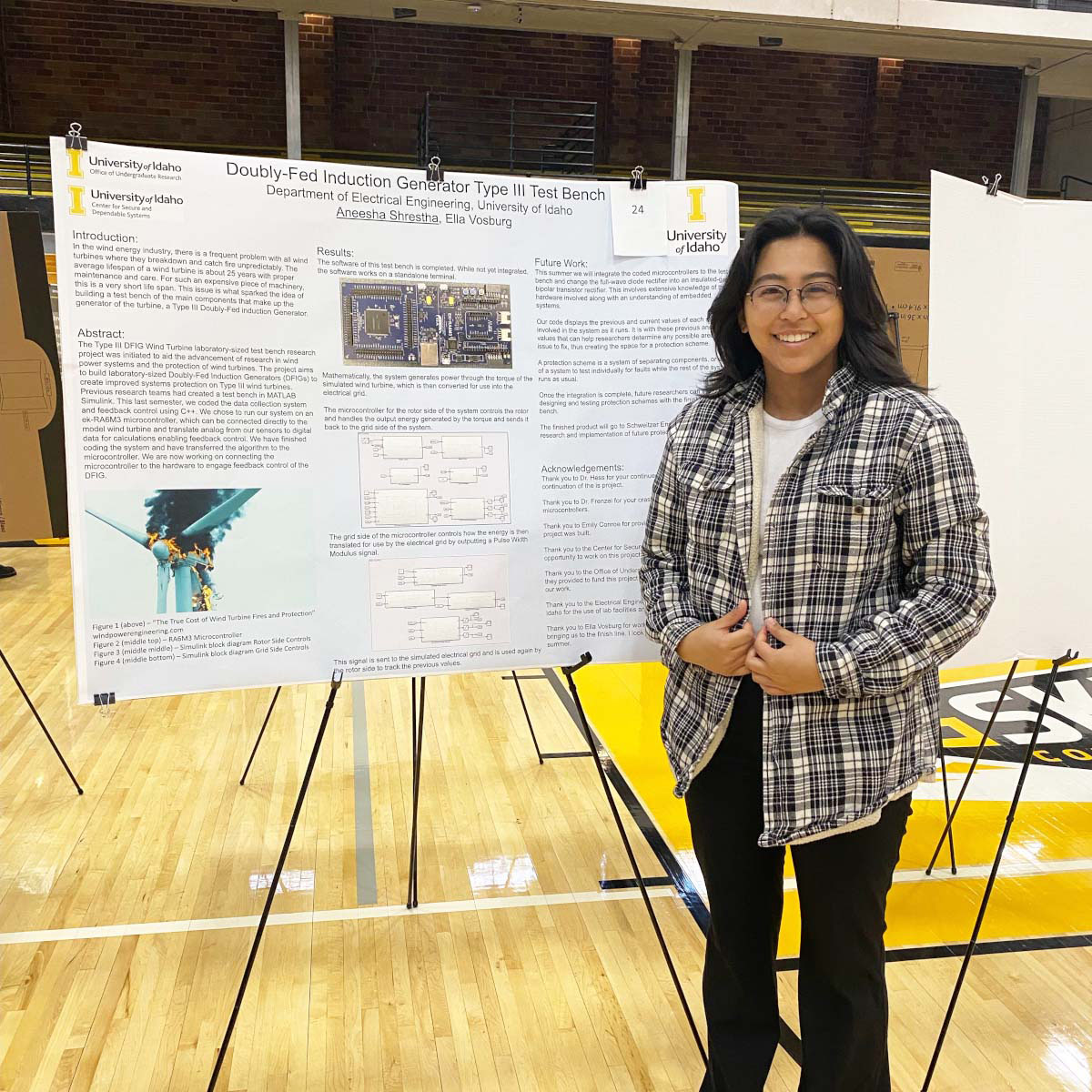
Aneesha is spending her summer coding and integrating software to lengthen the average lifespan of wind turbines and help with future wind energy research as an intern for the Center for Secure and Dependable Systems at the University of Idaho!
Aneesha worked with a team of students in our Department of Electrical and Computer Engineering to build a fully operational, robust, modular, and reliable Type III Doubly-Fed Induction Generator (DFIG) Wind Turbine test bench.
The average lifespan of a wind turbine is about 25 years with proper maintenance and care. For such an expensive piece of machinery, that is a short lifespan. The test bench contains the main components that make up a turbine generator, allowing for advanced research capabilities on wind turbines for a fraction of the cost, specifically in the areas of power grid stability, protection and power quality.
Garrett Wells
Computer Science
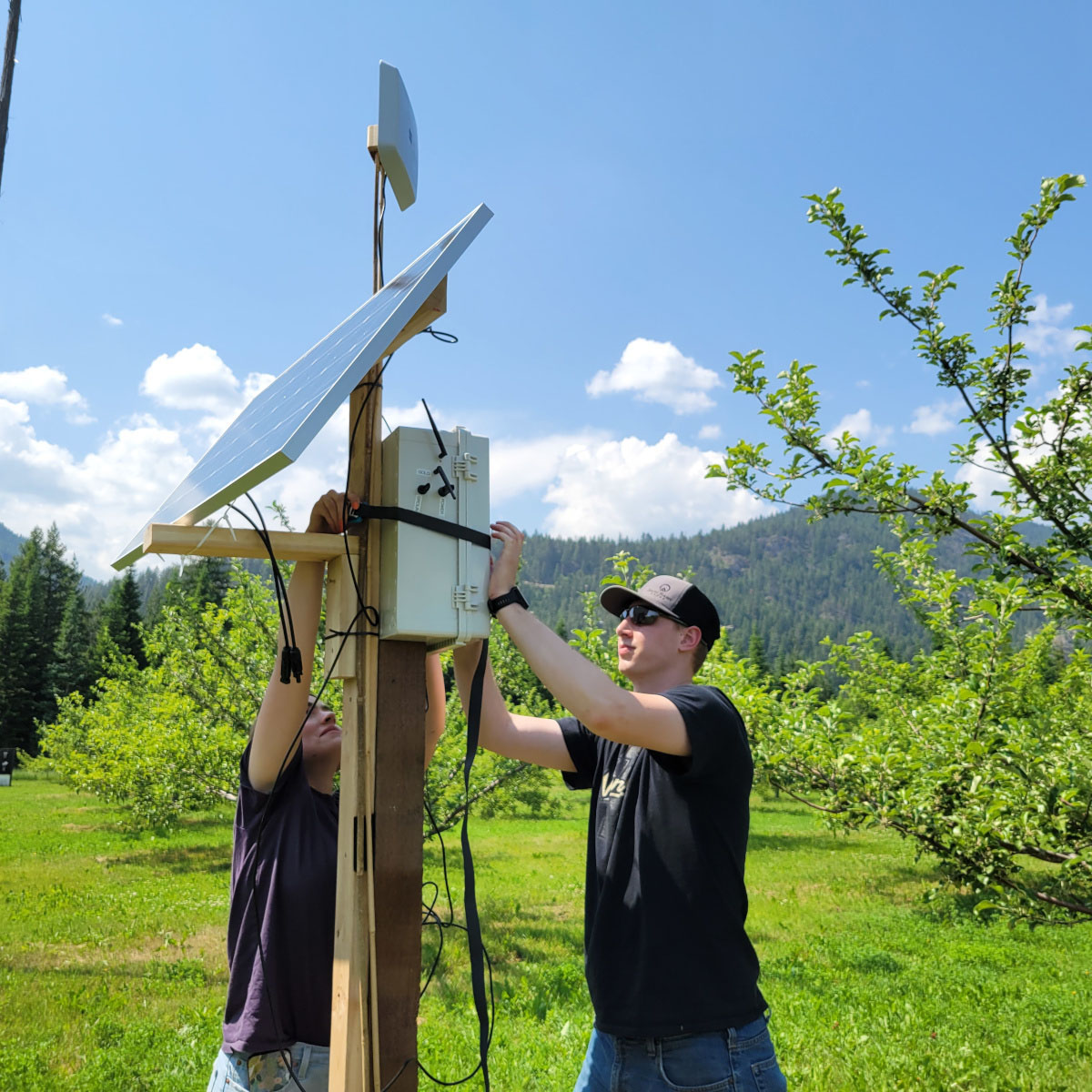
Vandal engineers are improving organic and sustainable crop production using artificial intelligence!
Computer science students Lacey Hunt, Mary Everett and Garrett Wells recently visited the Sandpoint Organic Agriculture Center to install an AI test system that will help orchard operators track environmental conditions, including temperature, light, wind speed, and moisture, to make better decisions for the care of the unique heirloom fruit varieties that grow there.
The computer system and sensors will help the team test and make revisions to a larger system they are building to help vineyard owners Jaclyn and Dustin Mommen of Laurel Grove Wine Farm in Virginia focus on their passion for sustainable business.
Last summer, the team traveled to Virginia to set up weather stations on the rolling 120-acre vineyard. The completed intelligent communication network will help the vineyard reduce power consumption and defray operating costs.
Mckenzie Reid, William Thielman, William Huntsman, and Joseph Cicanese
Mechanical Engineering
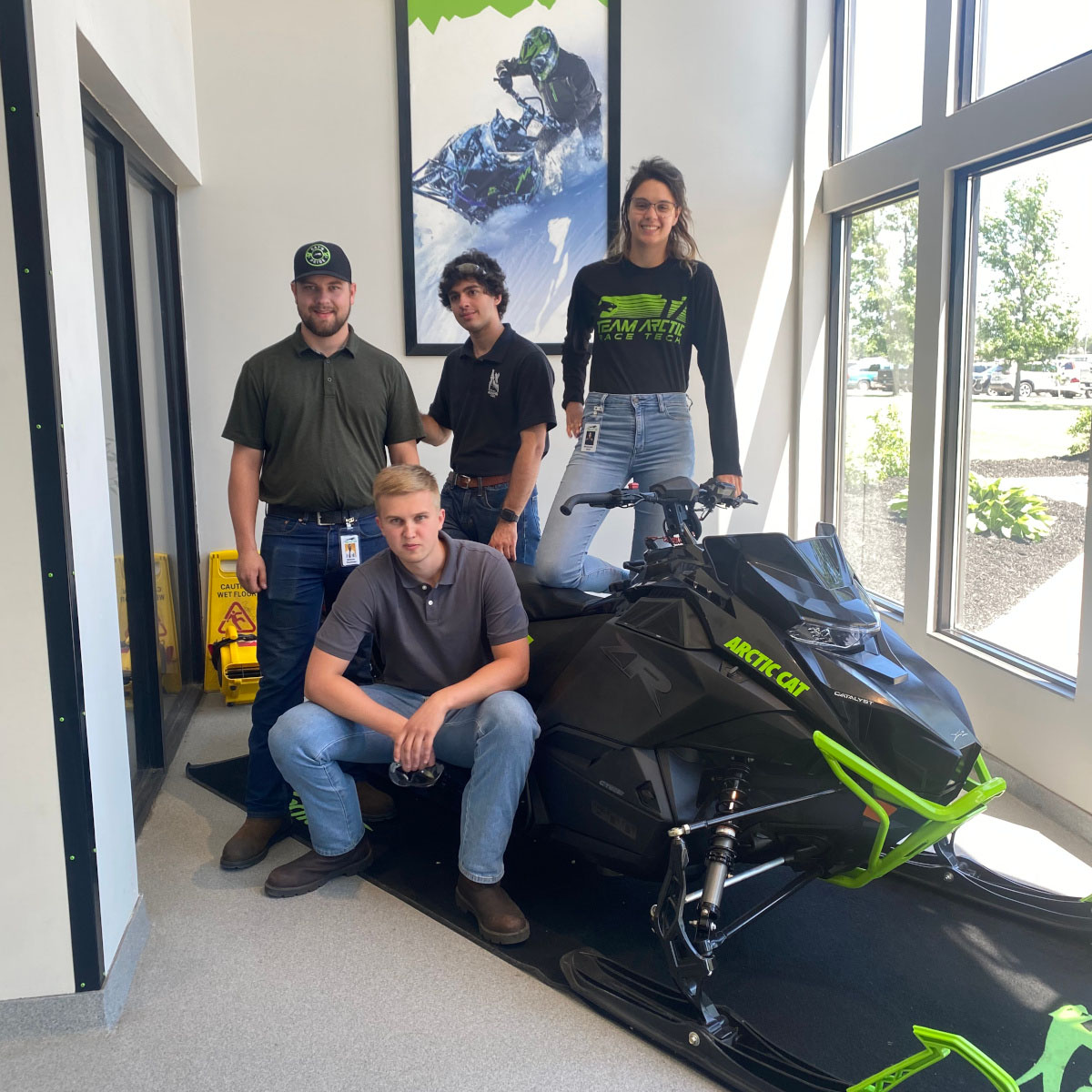
Vandal engineers represent Arctic Cat!
Mechanical engineering students Mckenzie Reid, William Thielman, William Huntsman, and Joseph Cicanese all interned this summer at the snowmobile and all-terrain vehicle manufacturer to test their skills and learn more about the powersports industry.
These students are also part of our Idaho Clean Snowmobile Challenge Team. This interdisciplinary team competes annually in a weeklong challenge to produce innovative solutions for a cleaner, quieter and more efficient snowmobile practical for manufacturers and enthusiasts alike. For 11 years, the team has earned top placement in the national competition.
NASA Nationwide Eclipse Ballooning Program
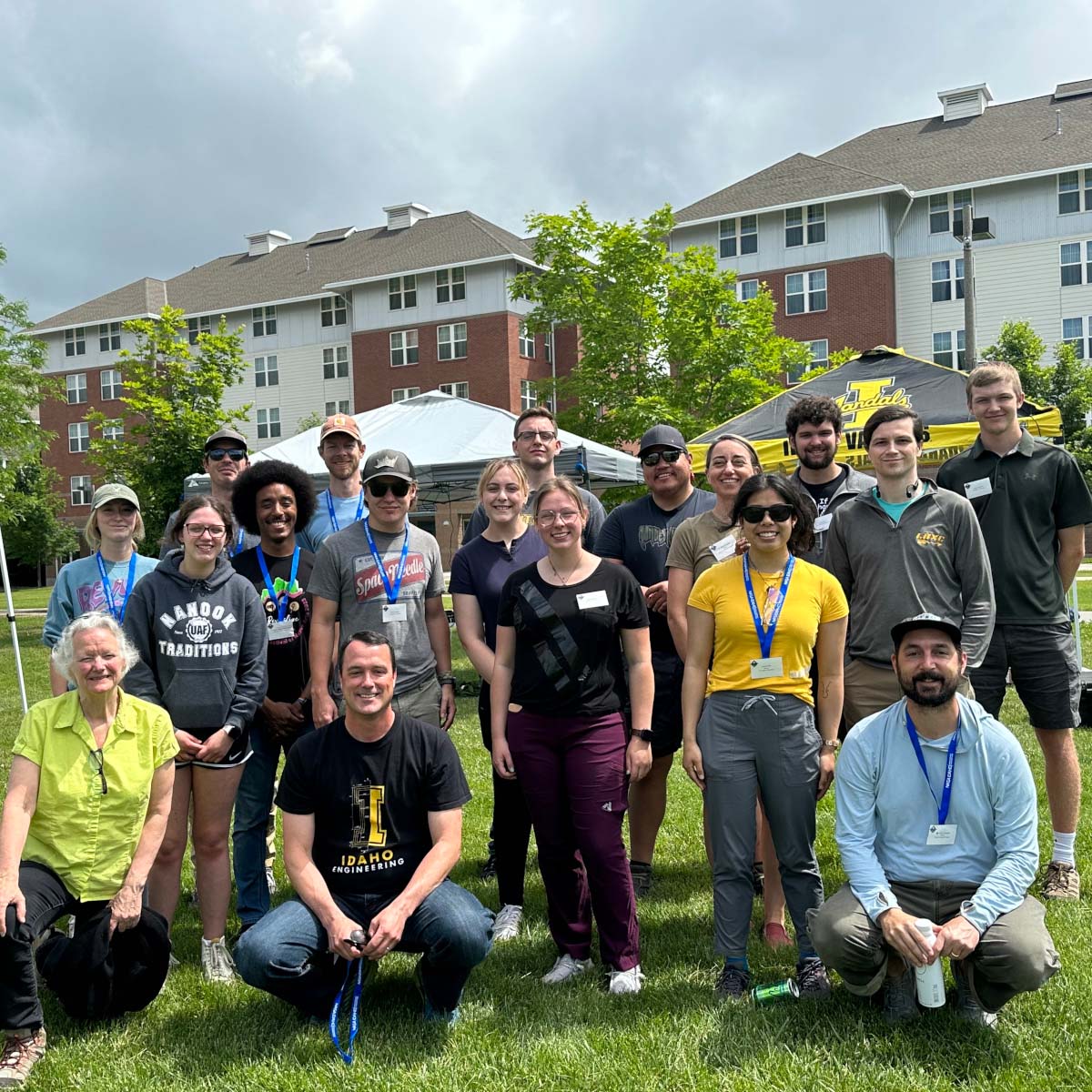
Gathering data for NASA takes practice!
Vandal engineers Konstantine Geranios, Caeley Hodges and Logan Kearney are conducting regular balloon launches this summer to help NASA better understand how gravity waves - large-scale disturbances in the atmosphere - can help us better predict weather patterns.
The team recently led a training workshop for the broader Nationwide Eclipse Ballooning Program (NEBP). Our college is the pod training lead for NEBP atmospheric science efforts, training mentors and team leads from Washington, Alaska, Montana, and Wyoming.
Scheduled launches will help our team prep for their trips to Oregon this fall and to Pennsylvania next year - during solar eclipse events – to track eclipse-induced waves that scientists have been trying to detect for decades.
Working under Chemical Engineering Associate Professor Matt Bernards, engineering students are continuing to build on NASA’s research. A team traveled to Chile in 2020, gathering launch data to gain a better understanding of Earth’s dynamic atmospheric and improve global weather forecast models and climate change mitigation processes.
Shashwot Niraula
Computer Science
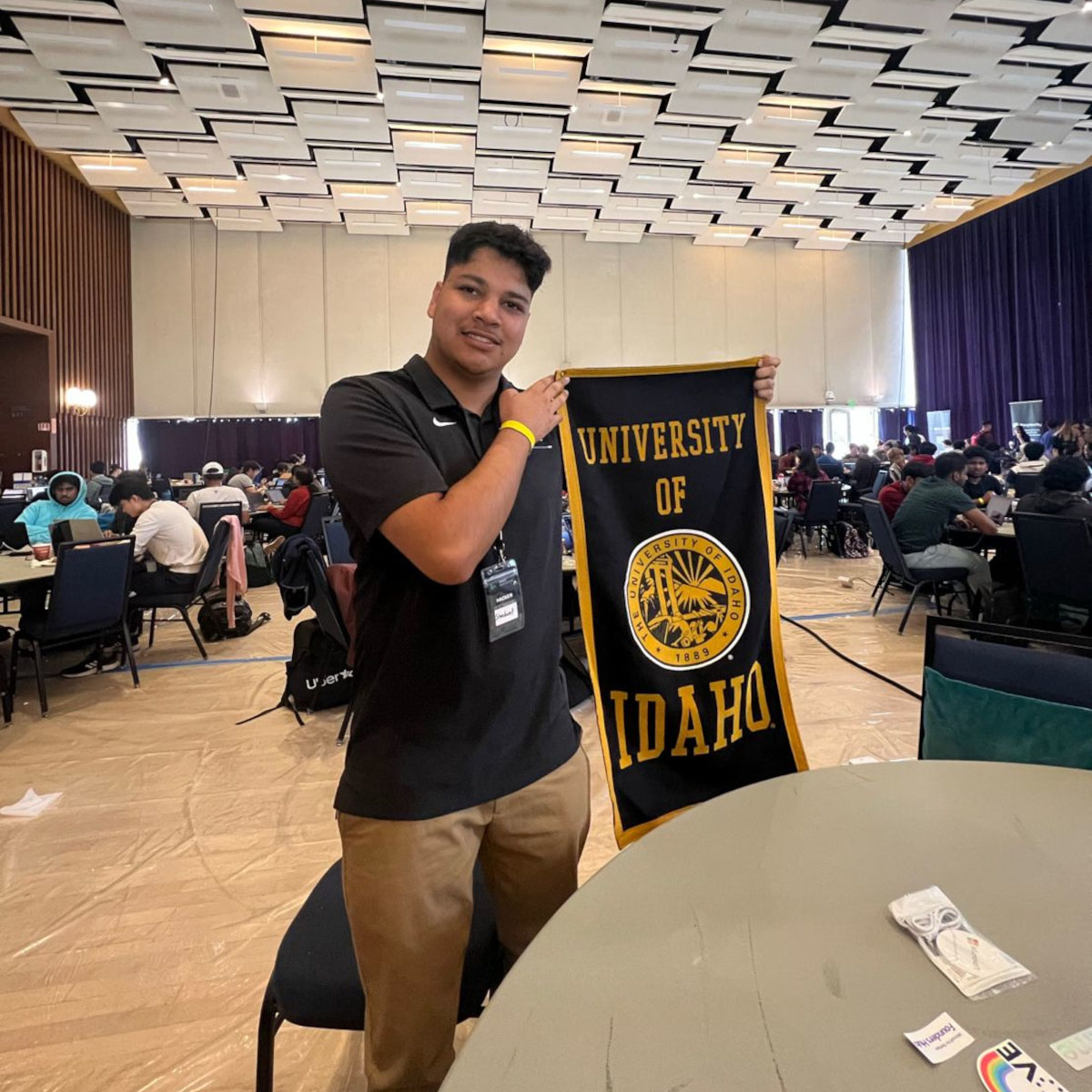
Thirty-six hour hackathon?! Yes, please!
Computer science junior Shashwot Niraula participated this summer in the UC Berkeley AI LLM Hackathon.
“Throughout this incredible journey, I gained a profound understanding of the implementation and capabilities of GPT3 and ChatGPT,” he said. “I learned how to use and customize natural language generative AI models through prompt engineering techniques and grasped the basics of integrating open AI models into applications.”
Virginia Herbord
Mechanical Engineering
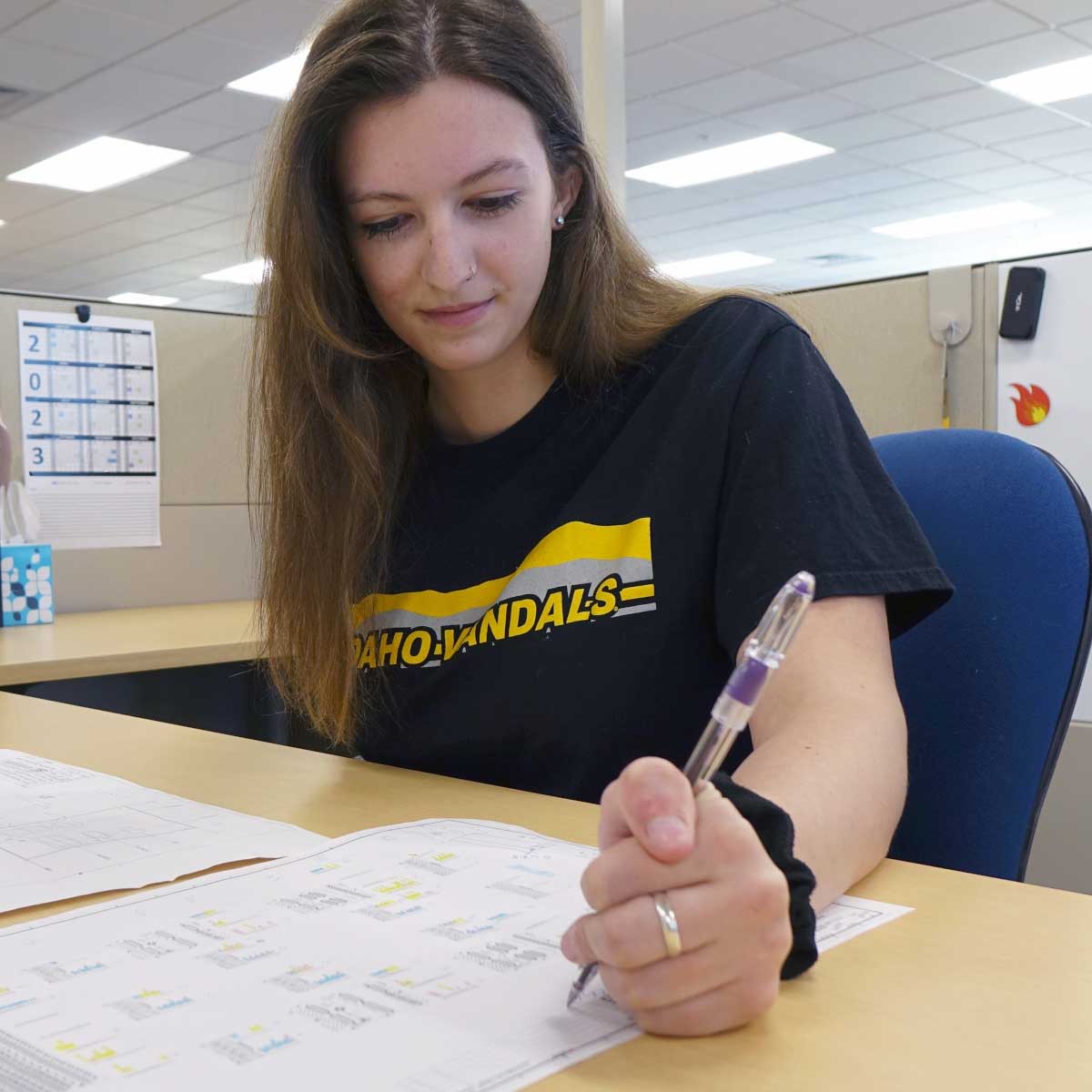
Improving global electric power is all in a summer’s work!
Mechanical engineering senior Virginia Herbord is an intern at Schweitzer Engineering Laboratories, working in the panel assembly factory. She designs and oversees the manufacturing of custom electrical enclosures for utility customers.
“These enclosures house our digital protective relay products that help keep the lights on around the world,” she said. “I use CAD software to help design the sheet metal plates and do fit checks for complex assemblies.”
Herbord also reviews electrical wiring drawings to create engraving files that are laser printed and placed into enclosures so correct components can easily be found.
Yangden Lama
Civil Engineering
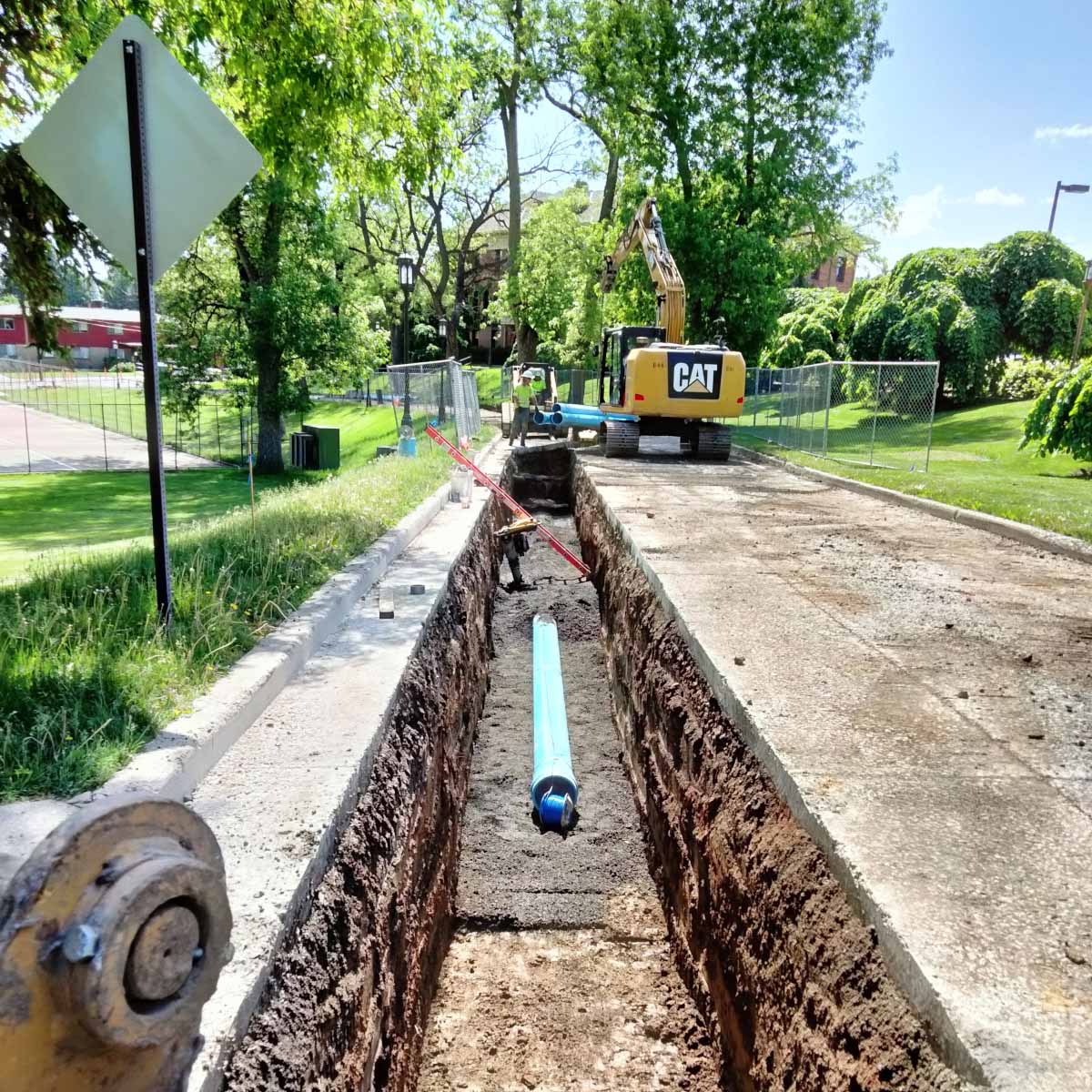
Vandal engineers spend their summers in paid hands-on faculty mentorship and employment positions.
Civil engineering junior Yangden Lama is an intern at J-U-B Engineering. Lama participated in a collaborative project to tie an old water line on the University of Idaho Moscow campus to a new location near Campus Drive. The project included relocating the fire hydrant, concrete cutting, laying new water lines, backfilling and conducting pressure testing.
“The experience allowed me to gain valuable insights into the intricacies of waterline projects,” she said. “J-U-B’s wonderful employees provided me with invaluable guidance and support. Their dedication to their work and the positive work environment is truly inspiring.”
Jennie Tafoya
Computer Science

Homecoming Tower Lights is going wireless thanks to Vandal innovation!
Computer science senior Jennie Tafoya spent her summer transforming the well-known Homecoming tradition to reduce hardware failure and maintain customizable control of the musical light show.
A microcontroller and set of color-changing LEDs will be placed in all 40 windows of the Theophilus Tower. Wireless control of the system makes it easier to custom code shows set to music, and pinpoint and fix errors when setting the show up for display.
The new system will eventually replace a 50-foot cable from the Tower basement. LED systems are wired together and strung room-to-room, opening up the possibility for many operational errors - like bad connections and broken hardware – and dramatically increasing pre-show testing time.
Korvin Jones
Civil Engineering

Vandal engineers are protecting Idaho’s 96,000 miles of rivers and streams!
Civil engineering junior Korvin Jones and doctoral student Nicole Hucke spent their summer in New Mexico gathering measurement data to better understand variations in the release of essential riverbed nutrients - carbon and phosphorus – and how nutrient levels impact river ecosystems and affect fish and wildlife – even those in Idaho.
The research is part of a Department of Energy-sponsored project under Center for Ecohydraulics Research (CER) Co-Director and Civil Engineering Professor Elowyn Yager and Research Assistant Professor Andy Tranmer.
Located in the highly-collaborative, multi-disciplinary environment of the Idaho Water Center in Boise, CER is changing the way we look at water and its impact on our lives.
CER faculty and students work with local, national and international entities to protect Idaho’s pristine waterways and balance the needs of our river systems and communities.
Lydia Beardsley
Mechanical Engineering

Senior mechanical engineering student Lydia Beardsley participated in University of Idaho Cooperative Education (Co-op) Program at Packaging Cooperation of America (CPA). Lydia was able to gain hands on experience doing real world engineering projects!
Her main project was working on a steam valve replacement system. Normally replacing this part of the plant requires big cranes, but to save time and money, Lydia helped innovate a better alternative using a crane attached to the building. She evaluated what rating the crane needed, sifted through past projects related to the issue, and job shadowed other engineers at the plant.
Lydia said this experience not only gave her insight into what kind of projects she may work on in a professional setting, but also strengthened her problem-solving and critical thinking skills.
Co-op offers an alternate to typical classroom study with on-the-job experience, and earn $20K+ as a student, making a lasting impact where you serve!
Mary Everett
Computer Science

Vandal engineers travel the globe to share their innovations!
Computer science doctoral student Mary Everett traveled to Bologna, Italy, this summer to present her team’s project to bring artificial intelligence to the wine industry at the European Conference on Precision Agriculture.
Mary and her team are working with Laurel Grove Wine Farm in Virginia to test SCARECRO, a remote-sensing intelligent communication network that will help vineyards reduce power consumption and defray operating costs. The system tracks environmental conditions, including temperature, light, wind speed, and moisture, to help owners make better business decisions and focus on sustainability.
In addition to touring vineyards across the Italian countryside, the conference gave Mary insight into a variety of precision agriculture topics and techniques. Mary presented alongside researchers from 40 different countries, discussing topics including remote and satellite sensing, drone usage, crop yield modeling and site-specific management.
Refer back to this website for more summer highlights!






